SWOT and PESTLE Analysis in Business
VerifiedAdded on 2020/06/06
|20
|5461
|73
AI Summary
This assignment examines the influence of both internal (SWOT) and external (PESTLE) factors on business performance. It explores how marketers utilize these frameworks to understand government intervention, technological advancements, and social trends that can impact a company's operations and profitability. The report provides a comprehensive analysis of how macro-factors like political, social, and technological influences shape the survival, growth, and success of businesses.
Contribute Materials
Your contribution can guide someone’s learning journey. Share your
documents today.
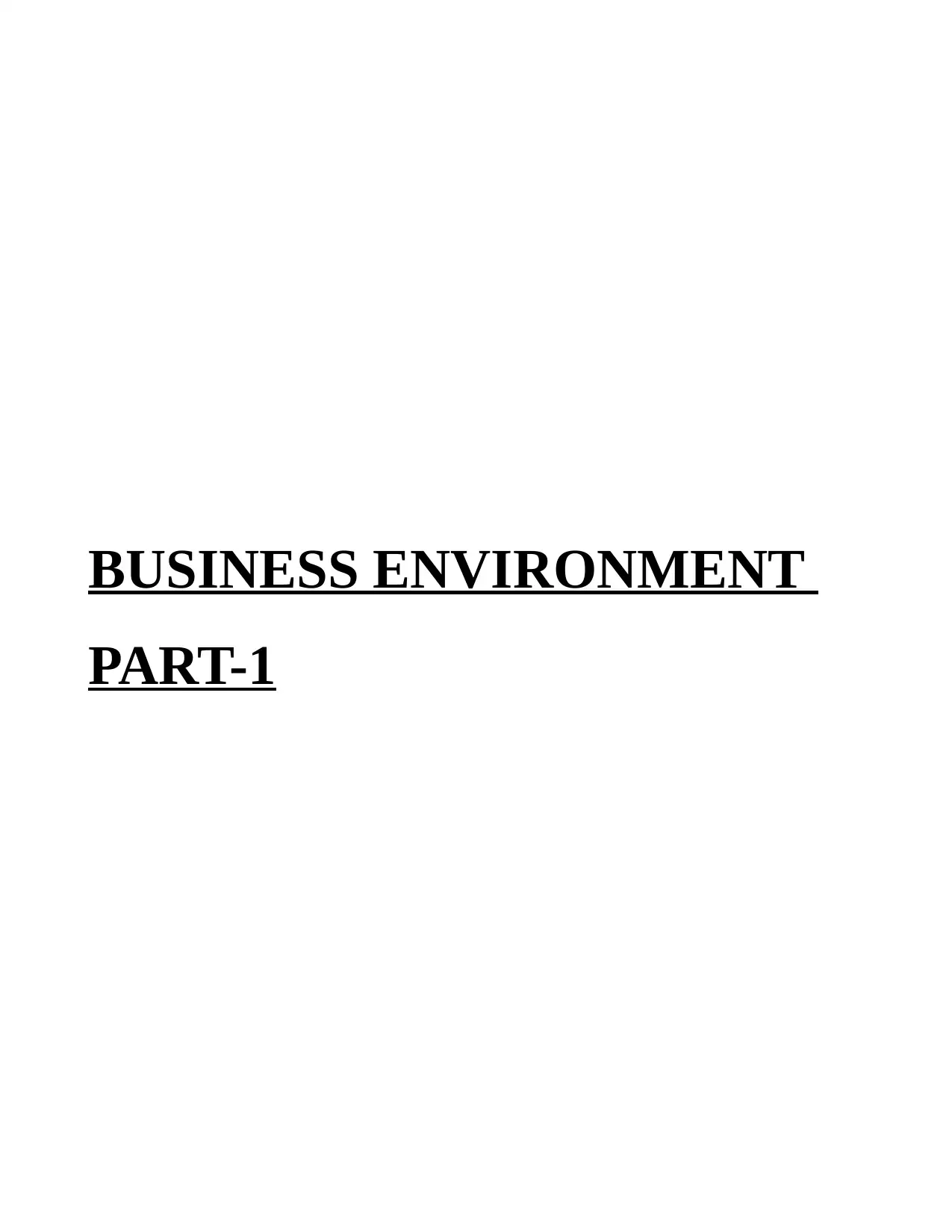
BUSINESS ENVIRONMENT
PART-1
PART-1
Secure Best Marks with AI Grader
Need help grading? Try our AI Grader for instant feedback on your assignments.
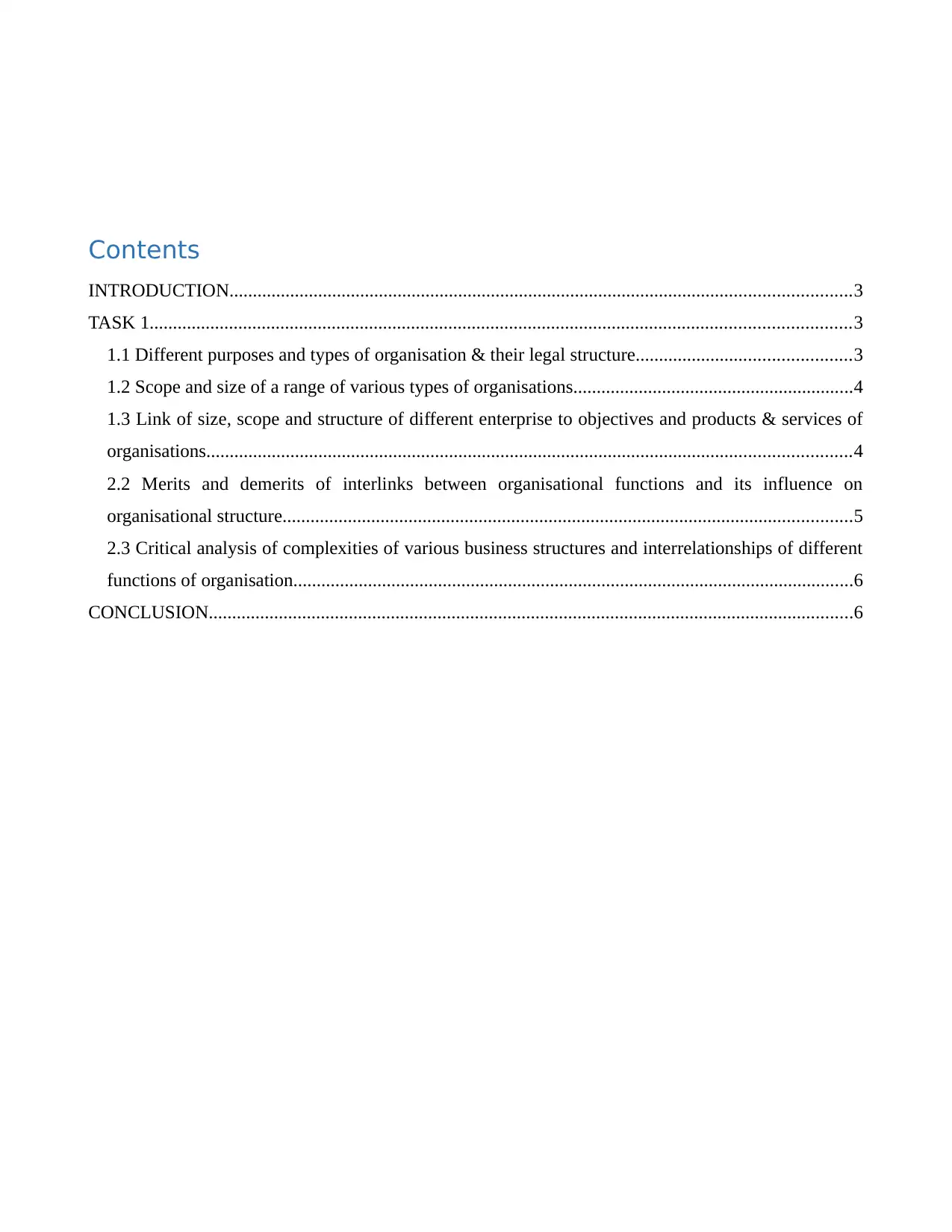
Contents
INTRODUCTION.....................................................................................................................................3
TASK 1......................................................................................................................................................3
1.1 Different purposes and types of organisation & their legal structure..............................................3
1.2 Scope and size of a range of various types of organisations............................................................4
1.3 Link of size, scope and structure of different enterprise to objectives and products & services of
organisations..........................................................................................................................................4
2.2 Merits and demerits of interlinks between organisational functions and its influence on
organisational structure..........................................................................................................................5
2.3 Critical analysis of complexities of various business structures and interrelationships of different
functions of organisation........................................................................................................................6
CONCLUSION..........................................................................................................................................6
INTRODUCTION.....................................................................................................................................3
TASK 1......................................................................................................................................................3
1.1 Different purposes and types of organisation & their legal structure..............................................3
1.2 Scope and size of a range of various types of organisations............................................................4
1.3 Link of size, scope and structure of different enterprise to objectives and products & services of
organisations..........................................................................................................................................4
2.2 Merits and demerits of interlinks between organisational functions and its influence on
organisational structure..........................................................................................................................5
2.3 Critical analysis of complexities of various business structures and interrelationships of different
functions of organisation........................................................................................................................6
CONCLUSION..........................................................................................................................................6
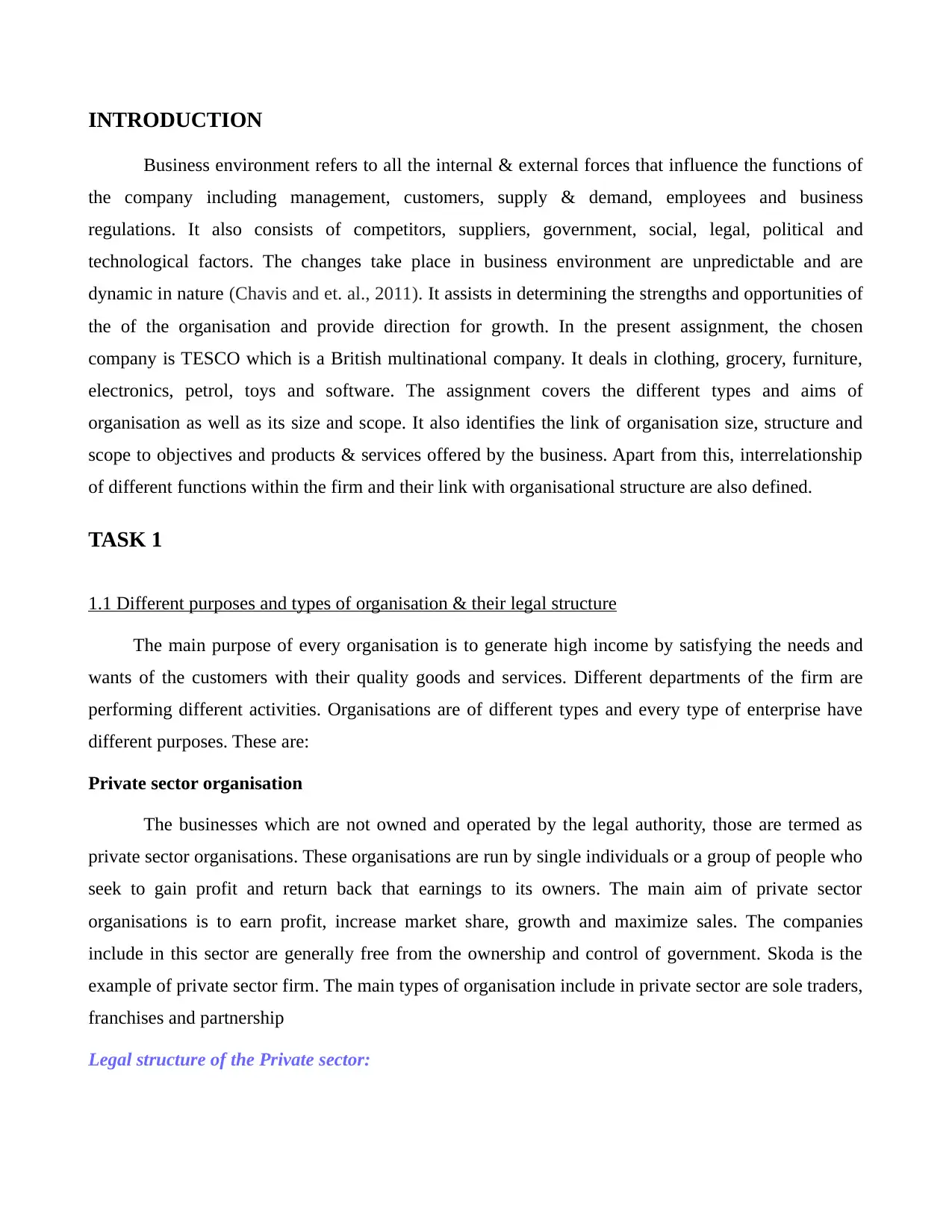
INTRODUCTION
Business environment refers to all the internal & external forces that influence the functions of
the company including management, customers, supply & demand, employees and business
regulations. It also consists of competitors, suppliers, government, social, legal, political and
technological factors. The changes take place in business environment are unpredictable and are
dynamic in nature (Chavis and et. al., 2011). It assists in determining the strengths and opportunities of
the of the organisation and provide direction for growth. In the present assignment, the chosen
company is TESCO which is a British multinational company. It deals in clothing, grocery, furniture,
electronics, petrol, toys and software. The assignment covers the different types and aims of
organisation as well as its size and scope. It also identifies the link of organisation size, structure and
scope to objectives and products & services offered by the business. Apart from this, interrelationship
of different functions within the firm and their link with organisational structure are also defined.
TASK 1
1.1 Different purposes and types of organisation & their legal structure
The main purpose of every organisation is to generate high income by satisfying the needs and
wants of the customers with their quality goods and services. Different departments of the firm are
performing different activities. Organisations are of different types and every type of enterprise have
different purposes. These are:
Private sector organisation
The businesses which are not owned and operated by the legal authority, those are termed as
private sector organisations. These organisations are run by single individuals or a group of people who
seek to gain profit and return back that earnings to its owners. The main aim of private sector
organisations is to earn profit, increase market share, growth and maximize sales. The companies
include in this sector are generally free from the ownership and control of government. Skoda is the
example of private sector firm. The main types of organisation include in private sector are sole traders,
franchises and partnership
Legal structure of the Private sector:
Business environment refers to all the internal & external forces that influence the functions of
the company including management, customers, supply & demand, employees and business
regulations. It also consists of competitors, suppliers, government, social, legal, political and
technological factors. The changes take place in business environment are unpredictable and are
dynamic in nature (Chavis and et. al., 2011). It assists in determining the strengths and opportunities of
the of the organisation and provide direction for growth. In the present assignment, the chosen
company is TESCO which is a British multinational company. It deals in clothing, grocery, furniture,
electronics, petrol, toys and software. The assignment covers the different types and aims of
organisation as well as its size and scope. It also identifies the link of organisation size, structure and
scope to objectives and products & services offered by the business. Apart from this, interrelationship
of different functions within the firm and their link with organisational structure are also defined.
TASK 1
1.1 Different purposes and types of organisation & their legal structure
The main purpose of every organisation is to generate high income by satisfying the needs and
wants of the customers with their quality goods and services. Different departments of the firm are
performing different activities. Organisations are of different types and every type of enterprise have
different purposes. These are:
Private sector organisation
The businesses which are not owned and operated by the legal authority, those are termed as
private sector organisations. These organisations are run by single individuals or a group of people who
seek to gain profit and return back that earnings to its owners. The main aim of private sector
organisations is to earn profit, increase market share, growth and maximize sales. The companies
include in this sector are generally free from the ownership and control of government. Skoda is the
example of private sector firm. The main types of organisation include in private sector are sole traders,
franchises and partnership
Legal structure of the Private sector:
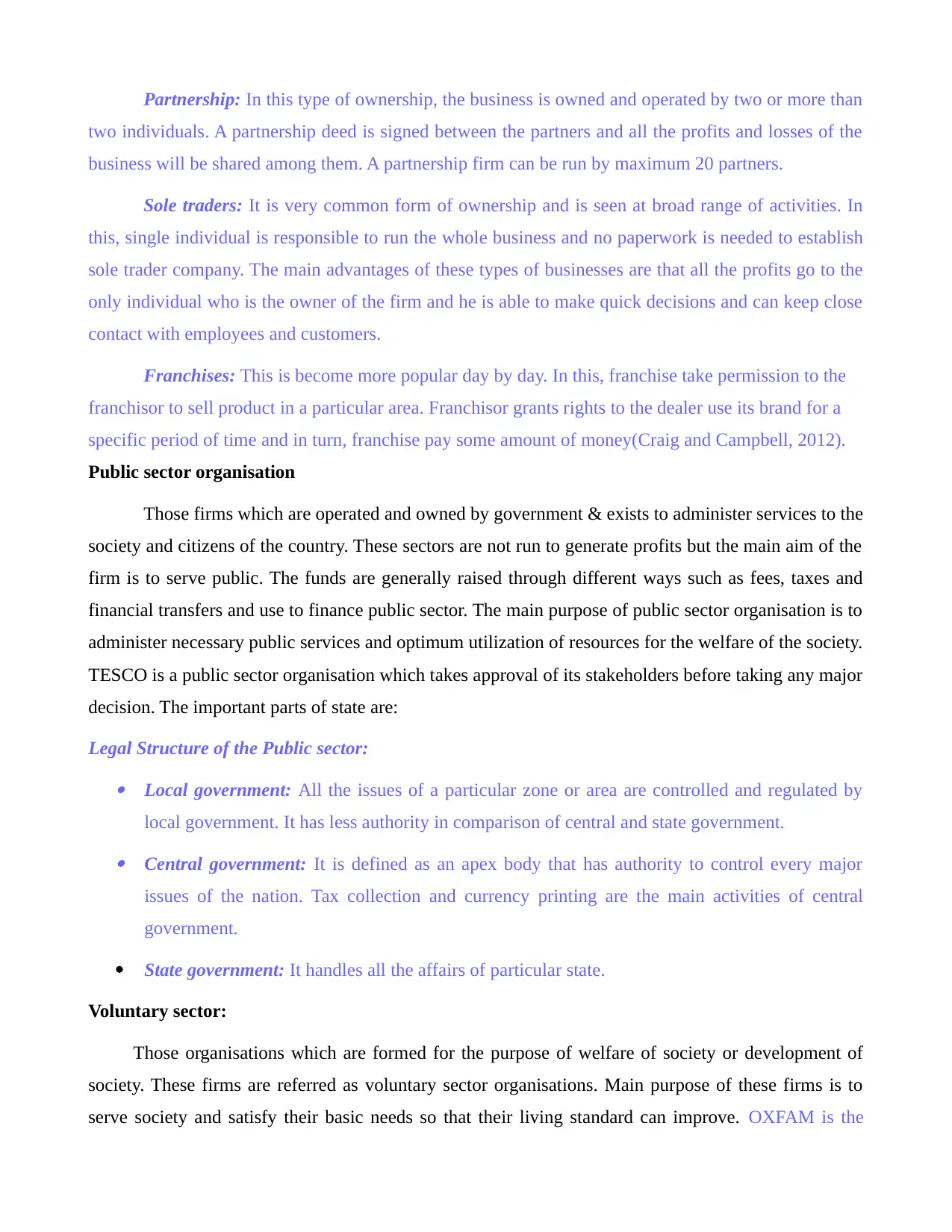
Partnership: In this type of ownership, the business is owned and operated by two or more than
two individuals. A partnership deed is signed between the partners and all the profits and losses of the
business will be shared among them. A partnership firm can be run by maximum 20 partners.
Sole traders: It is very common form of ownership and is seen at broad range of activities. In
this, single individual is responsible to run the whole business and no paperwork is needed to establish
sole trader company. The main advantages of these types of businesses are that all the profits go to the
only individual who is the owner of the firm and he is able to make quick decisions and can keep close
contact with employees and customers.
Franchises: This is become more popular day by day. In this, franchise take permission to the
franchisor to sell product in a particular area. Franchisor grants rights to the dealer use its brand for a
specific period of time and in turn, franchise pay some amount of money(Craig and Campbell, 2012).
Public sector organisation
Those firms which are operated and owned by government & exists to administer services to the
society and citizens of the country. These sectors are not run to generate profits but the main aim of the
firm is to serve public. The funds are generally raised through different ways such as fees, taxes and
financial transfers and use to finance public sector. The main purpose of public sector organisation is to
administer necessary public services and optimum utilization of resources for the welfare of the society.
TESCO is a public sector organisation which takes approval of its stakeholders before taking any major
decision. The important parts of state are:
Legal Structure of the Public sector:
Local government: All the issues of a particular zone or area are controlled and regulated by
local government. It has less authority in comparison of central and state government.
Central government: It is defined as an apex body that has authority to control every major
issues of the nation. Tax collection and currency printing are the main activities of central
government.
State government: It handles all the affairs of particular state.
Voluntary sector:
Those organisations which are formed for the purpose of welfare of society or development of
society. These firms are referred as voluntary sector organisations. Main purpose of these firms is to
serve society and satisfy their basic needs so that their living standard can improve. OXFAM is the
two individuals. A partnership deed is signed between the partners and all the profits and losses of the
business will be shared among them. A partnership firm can be run by maximum 20 partners.
Sole traders: It is very common form of ownership and is seen at broad range of activities. In
this, single individual is responsible to run the whole business and no paperwork is needed to establish
sole trader company. The main advantages of these types of businesses are that all the profits go to the
only individual who is the owner of the firm and he is able to make quick decisions and can keep close
contact with employees and customers.
Franchises: This is become more popular day by day. In this, franchise take permission to the
franchisor to sell product in a particular area. Franchisor grants rights to the dealer use its brand for a
specific period of time and in turn, franchise pay some amount of money(Craig and Campbell, 2012).
Public sector organisation
Those firms which are operated and owned by government & exists to administer services to the
society and citizens of the country. These sectors are not run to generate profits but the main aim of the
firm is to serve public. The funds are generally raised through different ways such as fees, taxes and
financial transfers and use to finance public sector. The main purpose of public sector organisation is to
administer necessary public services and optimum utilization of resources for the welfare of the society.
TESCO is a public sector organisation which takes approval of its stakeholders before taking any major
decision. The important parts of state are:
Legal Structure of the Public sector:
Local government: All the issues of a particular zone or area are controlled and regulated by
local government. It has less authority in comparison of central and state government.
Central government: It is defined as an apex body that has authority to control every major
issues of the nation. Tax collection and currency printing are the main activities of central
government.
State government: It handles all the affairs of particular state.
Voluntary sector:
Those organisations which are formed for the purpose of welfare of society or development of
society. These firms are referred as voluntary sector organisations. Main purpose of these firms is to
serve society and satisfy their basic needs so that their living standard can improve. OXFAM is the
Secure Best Marks with AI Grader
Need help grading? Try our AI Grader for instant feedback on your assignments.
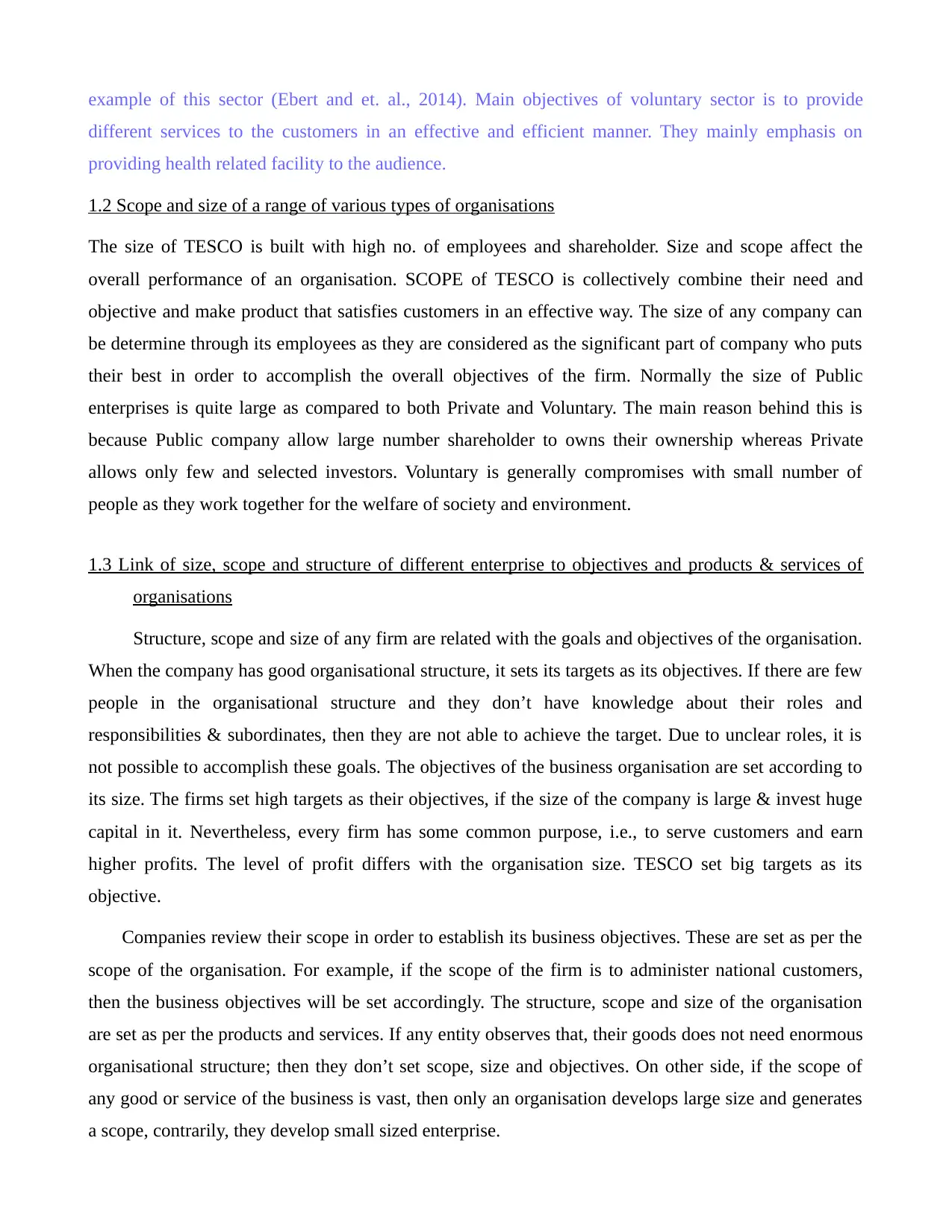
example of this sector (Ebert and et. al., 2014). Main objectives of voluntary sector is to provide
different services to the customers in an effective and efficient manner. They mainly emphasis on
providing health related facility to the audience.
1.2 Scope and size of a range of various types of organisations
The size of TESCO is built with high no. of employees and shareholder. Size and scope affect the
overall performance of an organisation. SCOPE of TESCO is collectively combine their need and
objective and make product that satisfies customers in an effective way. The size of any company can
be determine through its employees as they are considered as the significant part of company who puts
their best in order to accomplish the overall objectives of the firm. Normally the size of Public
enterprises is quite large as compared to both Private and Voluntary. The main reason behind this is
because Public company allow large number shareholder to owns their ownership whereas Private
allows only few and selected investors. Voluntary is generally compromises with small number of
people as they work together for the welfare of society and environment.
1.3 Link of size, scope and structure of different enterprise to objectives and products & services of
organisations
Structure, scope and size of any firm are related with the goals and objectives of the organisation.
When the company has good organisational structure, it sets its targets as its objectives. If there are few
people in the organisational structure and they don’t have knowledge about their roles and
responsibilities & subordinates, then they are not able to achieve the target. Due to unclear roles, it is
not possible to accomplish these goals. The objectives of the business organisation are set according to
its size. The firms set high targets as their objectives, if the size of the company is large & invest huge
capital in it. Nevertheless, every firm has some common purpose, i.e., to serve customers and earn
higher profits. The level of profit differs with the organisation size. TESCO set big targets as its
objective.
Companies review their scope in order to establish its business objectives. These are set as per the
scope of the organisation. For example, if the scope of the firm is to administer national customers,
then the business objectives will be set accordingly. The structure, scope and size of the organisation
are set as per the products and services. If any entity observes that, their goods does not need enormous
organisational structure; then they don’t set scope, size and objectives. On other side, if the scope of
any good or service of the business is vast, then only an organisation develops large size and generates
a scope, contrarily, they develop small sized enterprise.
different services to the customers in an effective and efficient manner. They mainly emphasis on
providing health related facility to the audience.
1.2 Scope and size of a range of various types of organisations
The size of TESCO is built with high no. of employees and shareholder. Size and scope affect the
overall performance of an organisation. SCOPE of TESCO is collectively combine their need and
objective and make product that satisfies customers in an effective way. The size of any company can
be determine through its employees as they are considered as the significant part of company who puts
their best in order to accomplish the overall objectives of the firm. Normally the size of Public
enterprises is quite large as compared to both Private and Voluntary. The main reason behind this is
because Public company allow large number shareholder to owns their ownership whereas Private
allows only few and selected investors. Voluntary is generally compromises with small number of
people as they work together for the welfare of society and environment.
1.3 Link of size, scope and structure of different enterprise to objectives and products & services of
organisations
Structure, scope and size of any firm are related with the goals and objectives of the organisation.
When the company has good organisational structure, it sets its targets as its objectives. If there are few
people in the organisational structure and they don’t have knowledge about their roles and
responsibilities & subordinates, then they are not able to achieve the target. Due to unclear roles, it is
not possible to accomplish these goals. The objectives of the business organisation are set according to
its size. The firms set high targets as their objectives, if the size of the company is large & invest huge
capital in it. Nevertheless, every firm has some common purpose, i.e., to serve customers and earn
higher profits. The level of profit differs with the organisation size. TESCO set big targets as its
objective.
Companies review their scope in order to establish its business objectives. These are set as per the
scope of the organisation. For example, if the scope of the firm is to administer national customers,
then the business objectives will be set accordingly. The structure, scope and size of the organisation
are set as per the products and services. If any entity observes that, their goods does not need enormous
organisational structure; then they don’t set scope, size and objectives. On other side, if the scope of
any good or service of the business is vast, then only an organisation develops large size and generates
a scope, contrarily, they develop small sized enterprise.
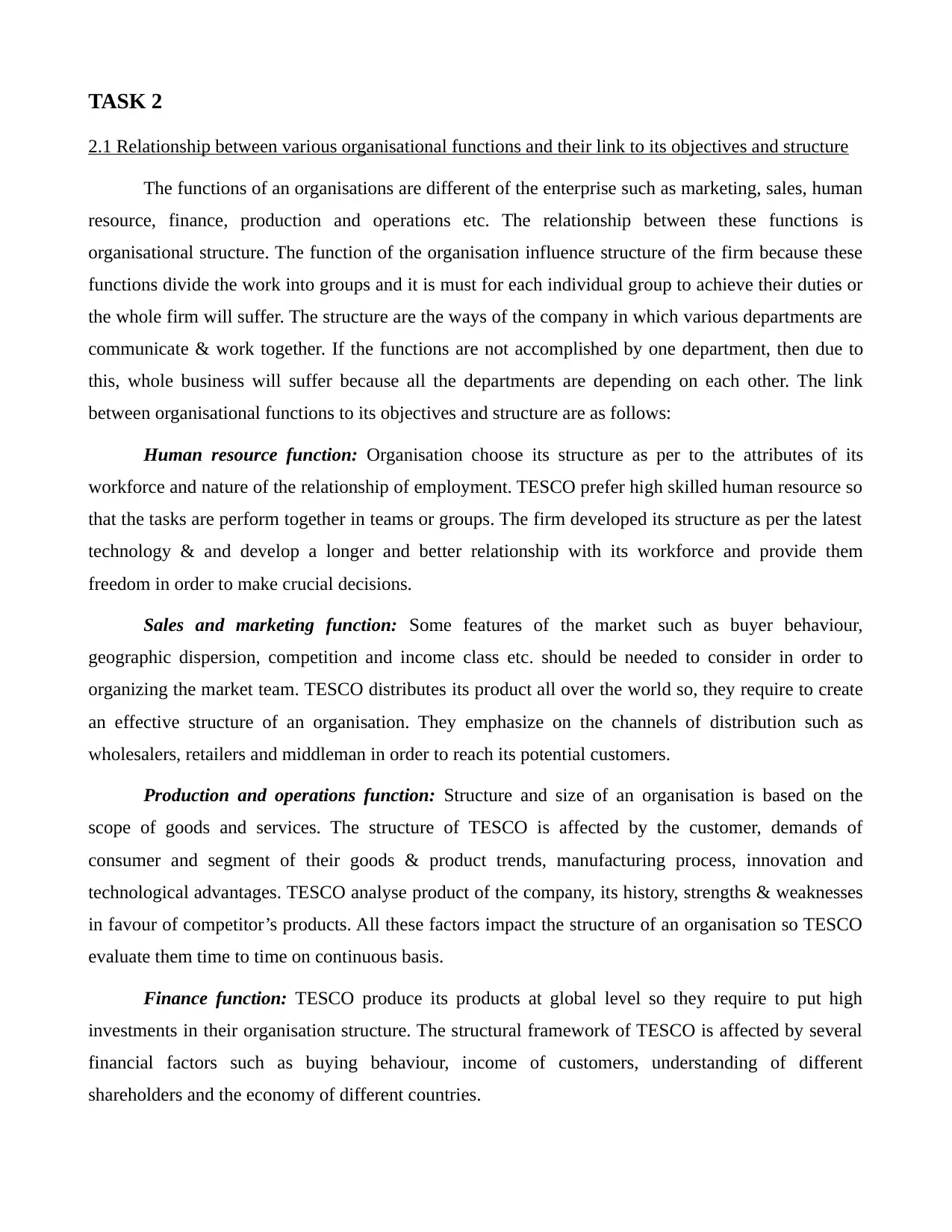
TASK 2
2.1 Relationship between various organisational functions and their link to its objectives and structure
The functions of an organisations are different of the enterprise such as marketing, sales, human
resource, finance, production and operations etc. The relationship between these functions is
organisational structure. The function of the organisation influence structure of the firm because these
functions divide the work into groups and it is must for each individual group to achieve their duties or
the whole firm will suffer. The structure are the ways of the company in which various departments are
communicate & work together. If the functions are not accomplished by one department, then due to
this, whole business will suffer because all the departments are depending on each other. The link
between organisational functions to its objectives and structure are as follows:
Human resource function: Organisation choose its structure as per to the attributes of its
workforce and nature of the relationship of employment. TESCO prefer high skilled human resource so
that the tasks are perform together in teams or groups. The firm developed its structure as per the latest
technology & and develop a longer and better relationship with its workforce and provide them
freedom in order to make crucial decisions.
Sales and marketing function: Some features of the market such as buyer behaviour,
geographic dispersion, competition and income class etc. should be needed to consider in order to
organizing the market team. TESCO distributes its product all over the world so, they require to create
an effective structure of an organisation. They emphasize on the channels of distribution such as
wholesalers, retailers and middleman in order to reach its potential customers.
Production and operations function: Structure and size of an organisation is based on the
scope of goods and services. The structure of TESCO is affected by the customer, demands of
consumer and segment of their goods & product trends, manufacturing process, innovation and
technological advantages. TESCO analyse product of the company, its history, strengths & weaknesses
in favour of competitor’s products. All these factors impact the structure of an organisation so TESCO
evaluate them time to time on continuous basis.
Finance function: TESCO produce its products at global level so they require to put high
investments in their organisation structure. The structural framework of TESCO is affected by several
financial factors such as buying behaviour, income of customers, understanding of different
shareholders and the economy of different countries.
2.1 Relationship between various organisational functions and their link to its objectives and structure
The functions of an organisations are different of the enterprise such as marketing, sales, human
resource, finance, production and operations etc. The relationship between these functions is
organisational structure. The function of the organisation influence structure of the firm because these
functions divide the work into groups and it is must for each individual group to achieve their duties or
the whole firm will suffer. The structure are the ways of the company in which various departments are
communicate & work together. If the functions are not accomplished by one department, then due to
this, whole business will suffer because all the departments are depending on each other. The link
between organisational functions to its objectives and structure are as follows:
Human resource function: Organisation choose its structure as per to the attributes of its
workforce and nature of the relationship of employment. TESCO prefer high skilled human resource so
that the tasks are perform together in teams or groups. The firm developed its structure as per the latest
technology & and develop a longer and better relationship with its workforce and provide them
freedom in order to make crucial decisions.
Sales and marketing function: Some features of the market such as buyer behaviour,
geographic dispersion, competition and income class etc. should be needed to consider in order to
organizing the market team. TESCO distributes its product all over the world so, they require to create
an effective structure of an organisation. They emphasize on the channels of distribution such as
wholesalers, retailers and middleman in order to reach its potential customers.
Production and operations function: Structure and size of an organisation is based on the
scope of goods and services. The structure of TESCO is affected by the customer, demands of
consumer and segment of their goods & product trends, manufacturing process, innovation and
technological advantages. TESCO analyse product of the company, its history, strengths & weaknesses
in favour of competitor’s products. All these factors impact the structure of an organisation so TESCO
evaluate them time to time on continuous basis.
Finance function: TESCO produce its products at global level so they require to put high
investments in their organisation structure. The structural framework of TESCO is affected by several
financial factors such as buying behaviour, income of customers, understanding of different
shareholders and the economy of different countries.
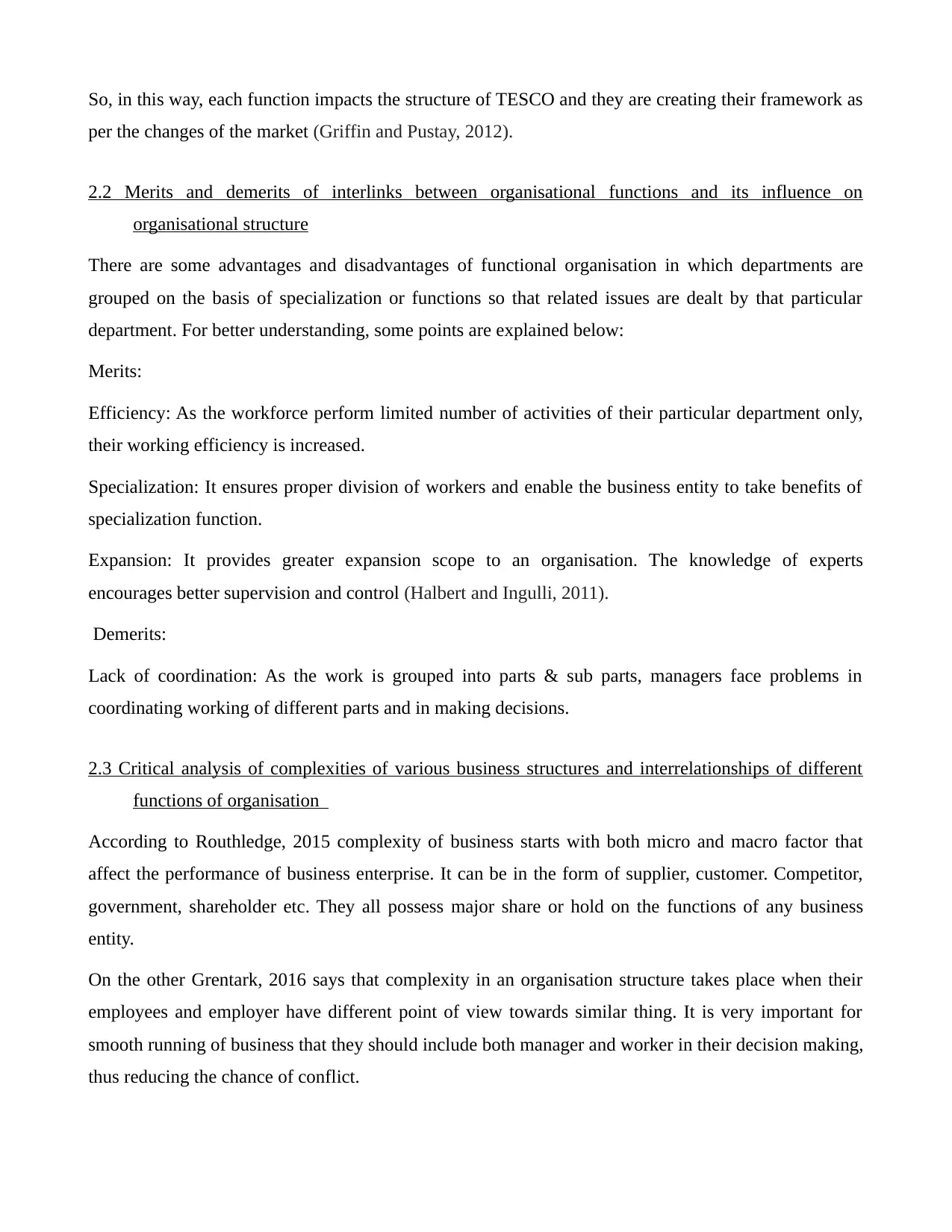
So, in this way, each function impacts the structure of TESCO and they are creating their framework as
per the changes of the market (Griffin and Pustay, 2012).
2.2 Merits and demerits of interlinks between organisational functions and its influence on
organisational structure
There are some advantages and disadvantages of functional organisation in which departments are
grouped on the basis of specialization or functions so that related issues are dealt by that particular
department. For better understanding, some points are explained below:
Merits:
Efficiency: As the workforce perform limited number of activities of their particular department only,
their working efficiency is increased.
Specialization: It ensures proper division of workers and enable the business entity to take benefits of
specialization function.
Expansion: It provides greater expansion scope to an organisation. The knowledge of experts
encourages better supervision and control (Halbert and Ingulli, 2011).
Demerits:
Lack of coordination: As the work is grouped into parts & sub parts, managers face problems in
coordinating working of different parts and in making decisions.
2.3 Critical analysis of complexities of various business structures and interrelationships of different
functions of organisation
According to Routhledge, 2015 complexity of business starts with both micro and macro factor that
affect the performance of business enterprise. It can be in the form of supplier, customer. Competitor,
government, shareholder etc. They all possess major share or hold on the functions of any business
entity.
On the other Grentark, 2016 says that complexity in an organisation structure takes place when their
employees and employer have different point of view towards similar thing. It is very important for
smooth running of business that they should include both manager and worker in their decision making,
thus reducing the chance of conflict.
per the changes of the market (Griffin and Pustay, 2012).
2.2 Merits and demerits of interlinks between organisational functions and its influence on
organisational structure
There are some advantages and disadvantages of functional organisation in which departments are
grouped on the basis of specialization or functions so that related issues are dealt by that particular
department. For better understanding, some points are explained below:
Merits:
Efficiency: As the workforce perform limited number of activities of their particular department only,
their working efficiency is increased.
Specialization: It ensures proper division of workers and enable the business entity to take benefits of
specialization function.
Expansion: It provides greater expansion scope to an organisation. The knowledge of experts
encourages better supervision and control (Halbert and Ingulli, 2011).
Demerits:
Lack of coordination: As the work is grouped into parts & sub parts, managers face problems in
coordinating working of different parts and in making decisions.
2.3 Critical analysis of complexities of various business structures and interrelationships of different
functions of organisation
According to Routhledge, 2015 complexity of business starts with both micro and macro factor that
affect the performance of business enterprise. It can be in the form of supplier, customer. Competitor,
government, shareholder etc. They all possess major share or hold on the functions of any business
entity.
On the other Grentark, 2016 says that complexity in an organisation structure takes place when their
employees and employer have different point of view towards similar thing. It is very important for
smooth running of business that they should include both manager and worker in their decision making,
thus reducing the chance of conflict.
Paraphrase This Document
Need a fresh take? Get an instant paraphrase of this document with our AI Paraphraser
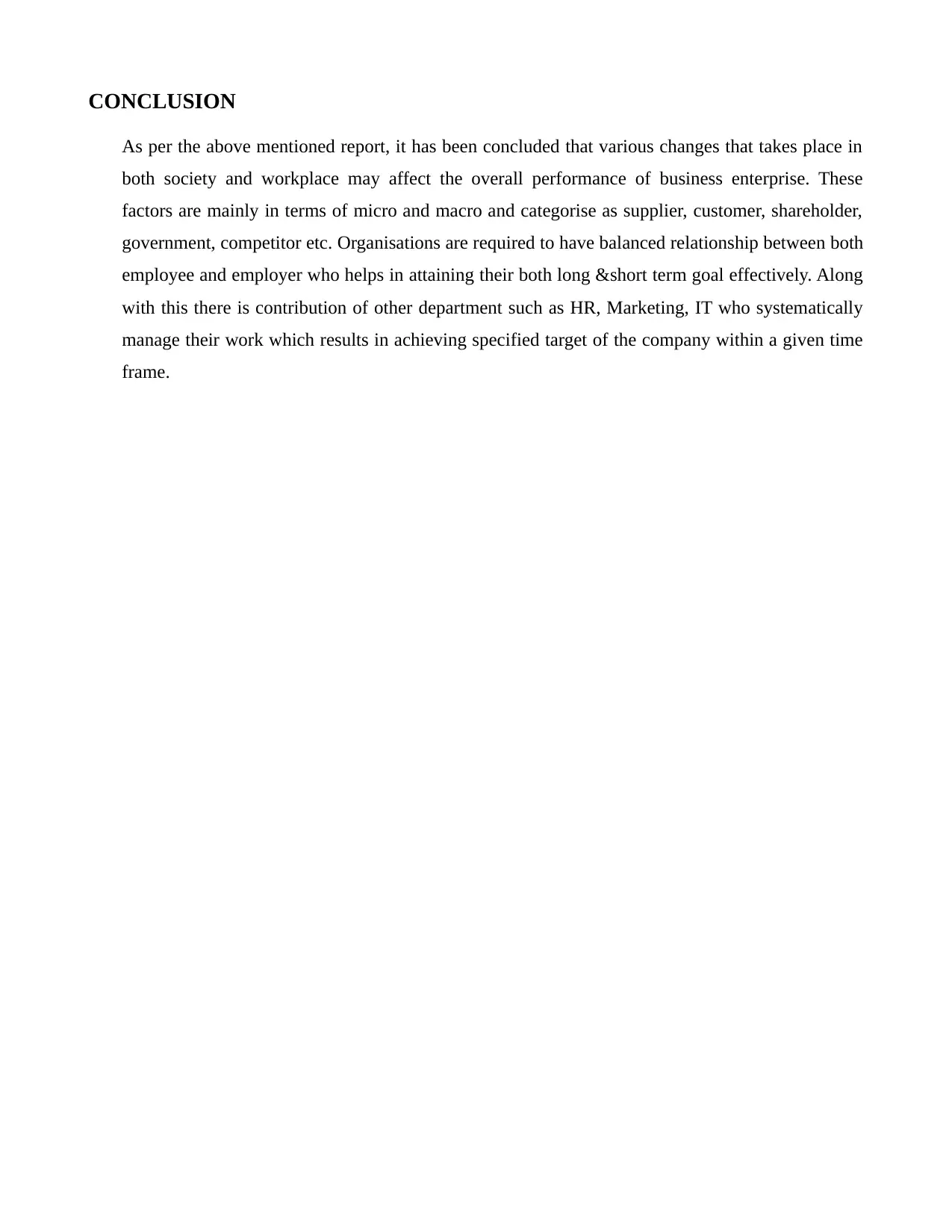
CONCLUSION
As per the above mentioned report, it has been concluded that various changes that takes place in
both society and workplace may affect the overall performance of business enterprise. These
factors are mainly in terms of micro and macro and categorise as supplier, customer, shareholder,
government, competitor etc. Organisations are required to have balanced relationship between both
employee and employer who helps in attaining their both long &short term goal effectively. Along
with this there is contribution of other department such as HR, Marketing, IT who systematically
manage their work which results in achieving specified target of the company within a given time
frame.
As per the above mentioned report, it has been concluded that various changes that takes place in
both society and workplace may affect the overall performance of business enterprise. These
factors are mainly in terms of micro and macro and categorise as supplier, customer, shareholder,
government, competitor etc. Organisations are required to have balanced relationship between both
employee and employer who helps in attaining their both long &short term goal effectively. Along
with this there is contribution of other department such as HR, Marketing, IT who systematically
manage their work which results in achieving specified target of the company within a given time
frame.
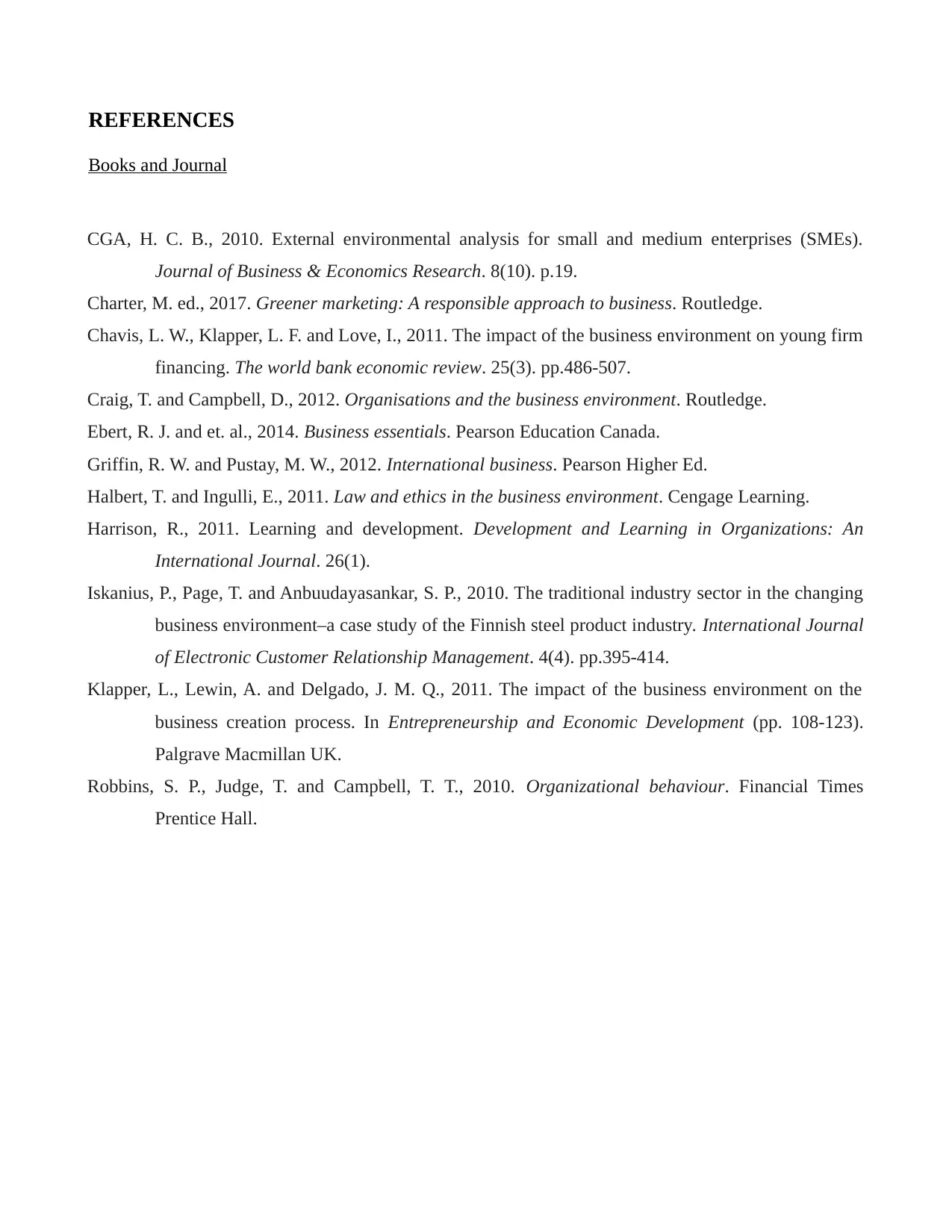
REFERENCES
Books and Journal
CGA, H. C. B., 2010. External environmental analysis for small and medium enterprises (SMEs).
Journal of Business & Economics Research. 8(10). p.19.
Charter, M. ed., 2017. Greener marketing: A responsible approach to business. Routledge.
Chavis, L. W., Klapper, L. F. and Love, I., 2011. The impact of the business environment on young firm
financing. The world bank economic review. 25(3). pp.486-507.
Craig, T. and Campbell, D., 2012. Organisations and the business environment. Routledge.
Ebert, R. J. and et. al., 2014. Business essentials. Pearson Education Canada.
Griffin, R. W. and Pustay, M. W., 2012. International business. Pearson Higher Ed.
Halbert, T. and Ingulli, E., 2011. Law and ethics in the business environment. Cengage Learning.
Harrison, R., 2011. Learning and development. Development and Learning in Organizations: An
International Journal. 26(1).
Iskanius, P., Page, T. and Anbuudayasankar, S. P., 2010. The traditional industry sector in the changing
business environment–a case study of the Finnish steel product industry. International Journal
of Electronic Customer Relationship Management. 4(4). pp.395-414.
Klapper, L., Lewin, A. and Delgado, J. M. Q., 2011. The impact of the business environment on the
business creation process. In Entrepreneurship and Economic Development (pp. 108-123).
Palgrave Macmillan UK.
Robbins, S. P., Judge, T. and Campbell, T. T., 2010. Organizational behaviour. Financial Times
Prentice Hall.
Books and Journal
CGA, H. C. B., 2010. External environmental analysis for small and medium enterprises (SMEs).
Journal of Business & Economics Research. 8(10). p.19.
Charter, M. ed., 2017. Greener marketing: A responsible approach to business. Routledge.
Chavis, L. W., Klapper, L. F. and Love, I., 2011. The impact of the business environment on young firm
financing. The world bank economic review. 25(3). pp.486-507.
Craig, T. and Campbell, D., 2012. Organisations and the business environment. Routledge.
Ebert, R. J. and et. al., 2014. Business essentials. Pearson Education Canada.
Griffin, R. W. and Pustay, M. W., 2012. International business. Pearson Higher Ed.
Halbert, T. and Ingulli, E., 2011. Law and ethics in the business environment. Cengage Learning.
Harrison, R., 2011. Learning and development. Development and Learning in Organizations: An
International Journal. 26(1).
Iskanius, P., Page, T. and Anbuudayasankar, S. P., 2010. The traditional industry sector in the changing
business environment–a case study of the Finnish steel product industry. International Journal
of Electronic Customer Relationship Management. 4(4). pp.395-414.
Klapper, L., Lewin, A. and Delgado, J. M. Q., 2011. The impact of the business environment on the
business creation process. In Entrepreneurship and Economic Development (pp. 108-123).
Palgrave Macmillan UK.
Robbins, S. P., Judge, T. and Campbell, T. T., 2010. Organizational behaviour. Financial Times
Prentice Hall.
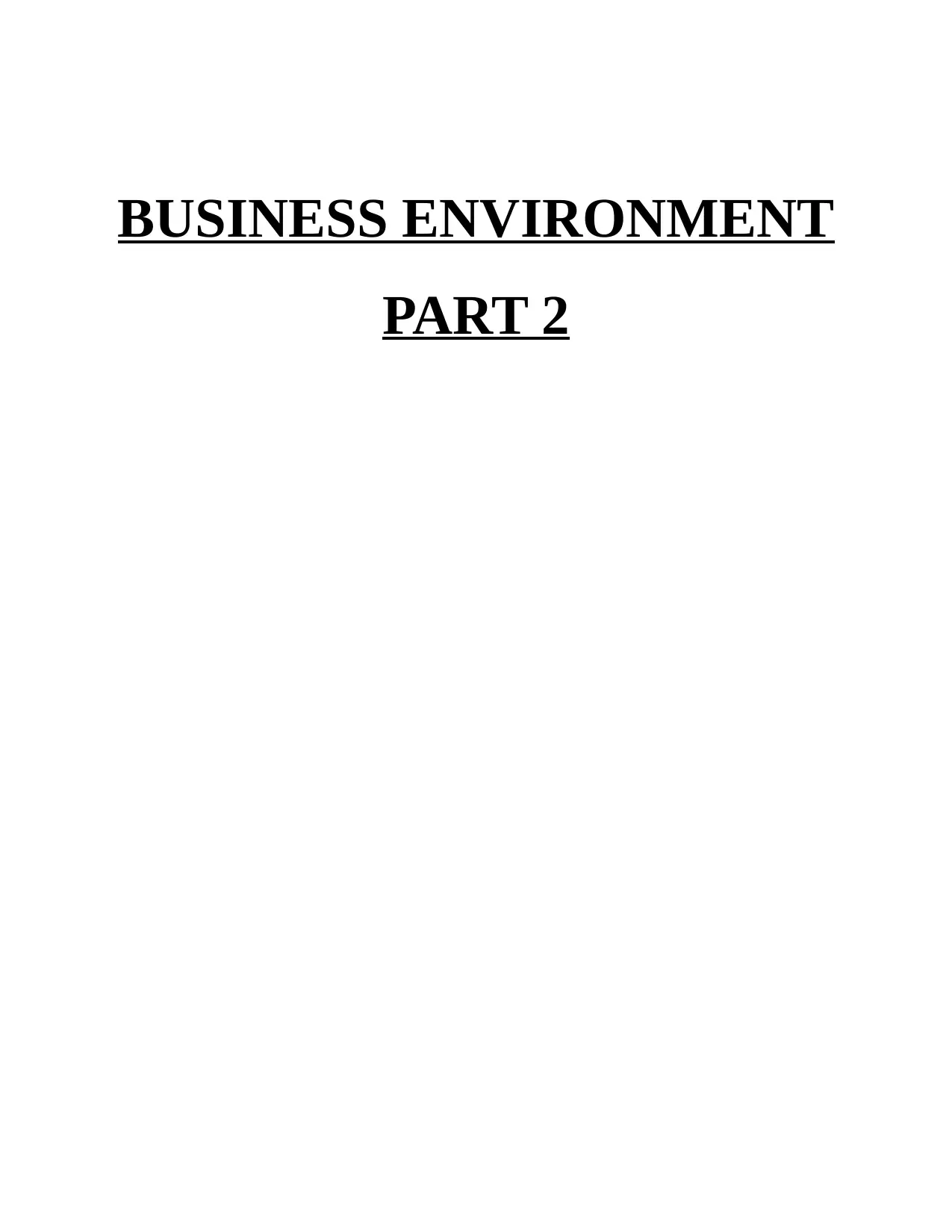
BUSINESS ENVIRONMENT
PART 2
PART 2
Secure Best Marks with AI Grader
Need help grading? Try our AI Grader for instant feedback on your assignments.
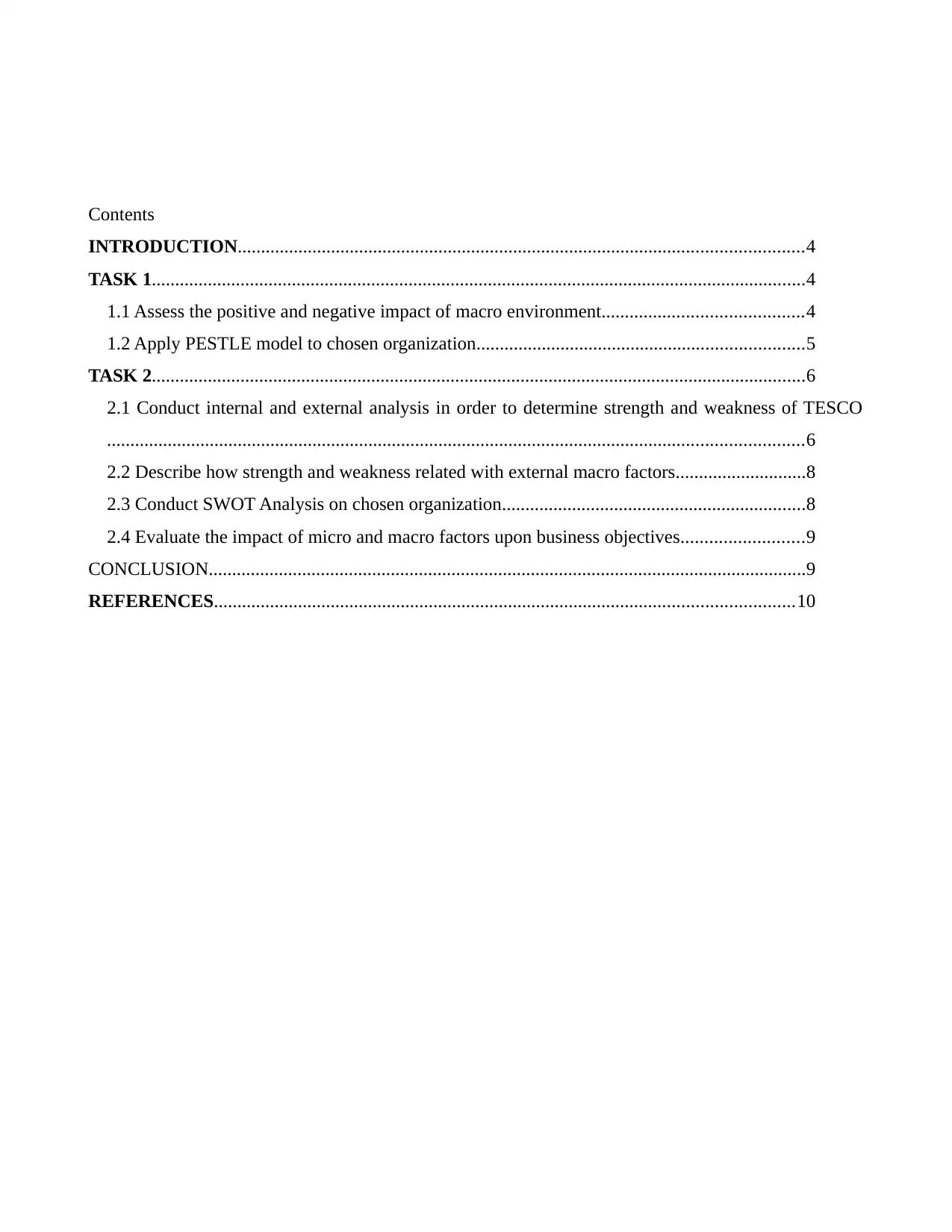
Contents
INTRODUCTION.........................................................................................................................4
TASK 1............................................................................................................................................4
1.1 Assess the positive and negative impact of macro environment...........................................4
1.2 Apply PESTLE model to chosen organization......................................................................5
TASK 2............................................................................................................................................6
2.1 Conduct internal and external analysis in order to determine strength and weakness of TESCO
.....................................................................................................................................................6
2.2 Describe how strength and weakness related with external macro factors............................8
2.3 Conduct SWOT Analysis on chosen organization.................................................................8
2.4 Evaluate the impact of micro and macro factors upon business objectives..........................9
CONCLUSION................................................................................................................................9
REFERENCES............................................................................................................................10
INTRODUCTION.........................................................................................................................4
TASK 1............................................................................................................................................4
1.1 Assess the positive and negative impact of macro environment...........................................4
1.2 Apply PESTLE model to chosen organization......................................................................5
TASK 2............................................................................................................................................6
2.1 Conduct internal and external analysis in order to determine strength and weakness of TESCO
.....................................................................................................................................................6
2.2 Describe how strength and weakness related with external macro factors............................8
2.3 Conduct SWOT Analysis on chosen organization.................................................................8
2.4 Evaluate the impact of micro and macro factors upon business objectives..........................9
CONCLUSION................................................................................................................................9
REFERENCES............................................................................................................................10
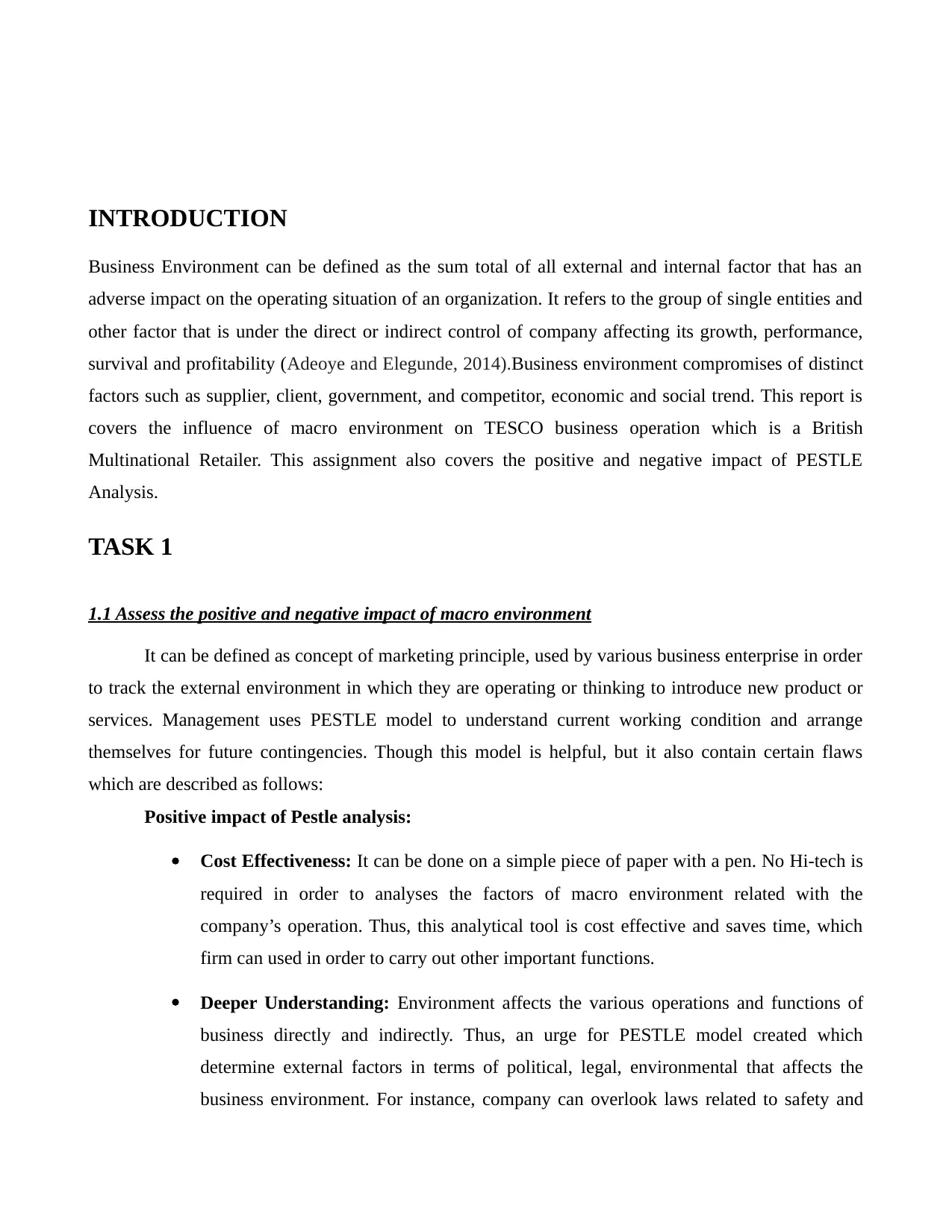
INTRODUCTION
Business Environment can be defined as the sum total of all external and internal factor that has an
adverse impact on the operating situation of an organization. It refers to the group of single entities and
other factor that is under the direct or indirect control of company affecting its growth, performance,
survival and profitability (Adeoye and Elegunde, 2014).Business environment compromises of distinct
factors such as supplier, client, government, and competitor, economic and social trend. This report is
covers the influence of macro environment on TESCO business operation which is a British
Multinational Retailer. This assignment also covers the positive and negative impact of PESTLE
Analysis.
TASK 1
1.1 Assess the positive and negative impact of macro environment
It can be defined as concept of marketing principle, used by various business enterprise in order
to track the external environment in which they are operating or thinking to introduce new product or
services. Management uses PESTLE model to understand current working condition and arrange
themselves for future contingencies. Though this model is helpful, but it also contain certain flaws
which are described as follows:
Positive impact of Pestle analysis:
Cost Effectiveness: It can be done on a simple piece of paper with a pen. No Hi-tech is
required in order to analyses the factors of macro environment related with the
company’s operation. Thus, this analytical tool is cost effective and saves time, which
firm can used in order to carry out other important functions.
Deeper Understanding: Environment affects the various operations and functions of
business directly and indirectly. Thus, an urge for PESTLE model created which
determine external factors in terms of political, legal, environmental that affects the
business environment. For instance, company can overlook laws related to safety and
Business Environment can be defined as the sum total of all external and internal factor that has an
adverse impact on the operating situation of an organization. It refers to the group of single entities and
other factor that is under the direct or indirect control of company affecting its growth, performance,
survival and profitability (Adeoye and Elegunde, 2014).Business environment compromises of distinct
factors such as supplier, client, government, and competitor, economic and social trend. This report is
covers the influence of macro environment on TESCO business operation which is a British
Multinational Retailer. This assignment also covers the positive and negative impact of PESTLE
Analysis.
TASK 1
1.1 Assess the positive and negative impact of macro environment
It can be defined as concept of marketing principle, used by various business enterprise in order
to track the external environment in which they are operating or thinking to introduce new product or
services. Management uses PESTLE model to understand current working condition and arrange
themselves for future contingencies. Though this model is helpful, but it also contain certain flaws
which are described as follows:
Positive impact of Pestle analysis:
Cost Effectiveness: It can be done on a simple piece of paper with a pen. No Hi-tech is
required in order to analyses the factors of macro environment related with the
company’s operation. Thus, this analytical tool is cost effective and saves time, which
firm can used in order to carry out other important functions.
Deeper Understanding: Environment affects the various operations and functions of
business directly and indirectly. Thus, an urge for PESTLE model created which
determine external factors in terms of political, legal, environmental that affects the
business environment. For instance, company can overlook laws related to safety and
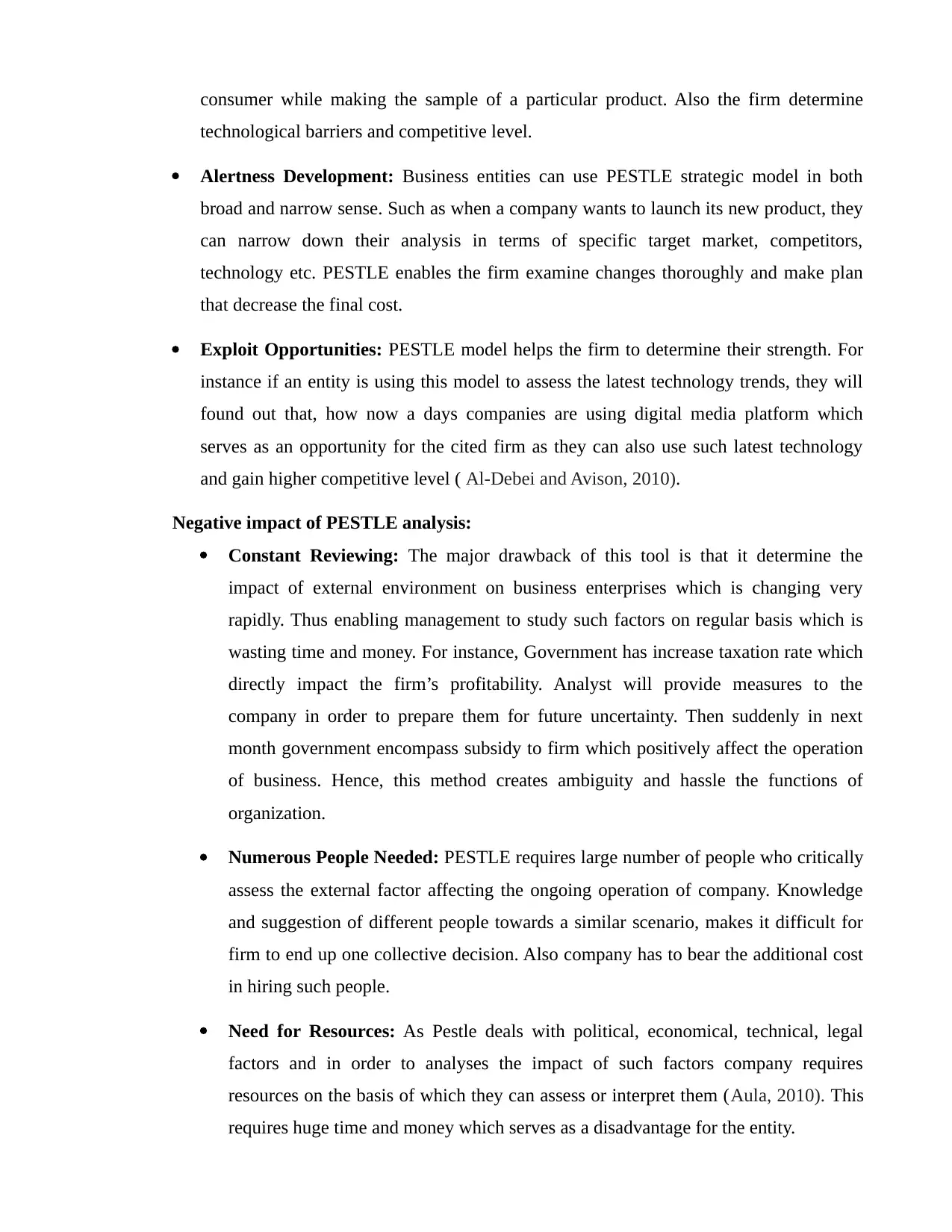
consumer while making the sample of a particular product. Also the firm determine
technological barriers and competitive level.
Alertness Development: Business entities can use PESTLE strategic model in both
broad and narrow sense. Such as when a company wants to launch its new product, they
can narrow down their analysis in terms of specific target market, competitors,
technology etc. PESTLE enables the firm examine changes thoroughly and make plan
that decrease the final cost.
Exploit Opportunities: PESTLE model helps the firm to determine their strength. For
instance if an entity is using this model to assess the latest technology trends, they will
found out that, how now a days companies are using digital media platform which
serves as an opportunity for the cited firm as they can also use such latest technology
and gain higher competitive level ( Al-Debei and Avison, 2010).
Negative impact of PESTLE analysis:
Constant Reviewing: The major drawback of this tool is that it determine the
impact of external environment on business enterprises which is changing very
rapidly. Thus enabling management to study such factors on regular basis which is
wasting time and money. For instance, Government has increase taxation rate which
directly impact the firm’s profitability. Analyst will provide measures to the
company in order to prepare them for future uncertainty. Then suddenly in next
month government encompass subsidy to firm which positively affect the operation
of business. Hence, this method creates ambiguity and hassle the functions of
organization.
Numerous People Needed: PESTLE requires large number of people who critically
assess the external factor affecting the ongoing operation of company. Knowledge
and suggestion of different people towards a similar scenario, makes it difficult for
firm to end up one collective decision. Also company has to bear the additional cost
in hiring such people.
Need for Resources: As Pestle deals with political, economical, technical, legal
factors and in order to analyses the impact of such factors company requires
resources on the basis of which they can assess or interpret them (Aula, 2010). This
requires huge time and money which serves as a disadvantage for the entity.
technological barriers and competitive level.
Alertness Development: Business entities can use PESTLE strategic model in both
broad and narrow sense. Such as when a company wants to launch its new product, they
can narrow down their analysis in terms of specific target market, competitors,
technology etc. PESTLE enables the firm examine changes thoroughly and make plan
that decrease the final cost.
Exploit Opportunities: PESTLE model helps the firm to determine their strength. For
instance if an entity is using this model to assess the latest technology trends, they will
found out that, how now a days companies are using digital media platform which
serves as an opportunity for the cited firm as they can also use such latest technology
and gain higher competitive level ( Al-Debei and Avison, 2010).
Negative impact of PESTLE analysis:
Constant Reviewing: The major drawback of this tool is that it determine the
impact of external environment on business enterprises which is changing very
rapidly. Thus enabling management to study such factors on regular basis which is
wasting time and money. For instance, Government has increase taxation rate which
directly impact the firm’s profitability. Analyst will provide measures to the
company in order to prepare them for future uncertainty. Then suddenly in next
month government encompass subsidy to firm which positively affect the operation
of business. Hence, this method creates ambiguity and hassle the functions of
organization.
Numerous People Needed: PESTLE requires large number of people who critically
assess the external factor affecting the ongoing operation of company. Knowledge
and suggestion of different people towards a similar scenario, makes it difficult for
firm to end up one collective decision. Also company has to bear the additional cost
in hiring such people.
Need for Resources: As Pestle deals with political, economical, technical, legal
factors and in order to analyses the impact of such factors company requires
resources on the basis of which they can assess or interpret them (Aula, 2010). This
requires huge time and money which serves as a disadvantage for the entity.
Paraphrase This Document
Need a fresh take? Get an instant paraphrase of this document with our AI Paraphraser
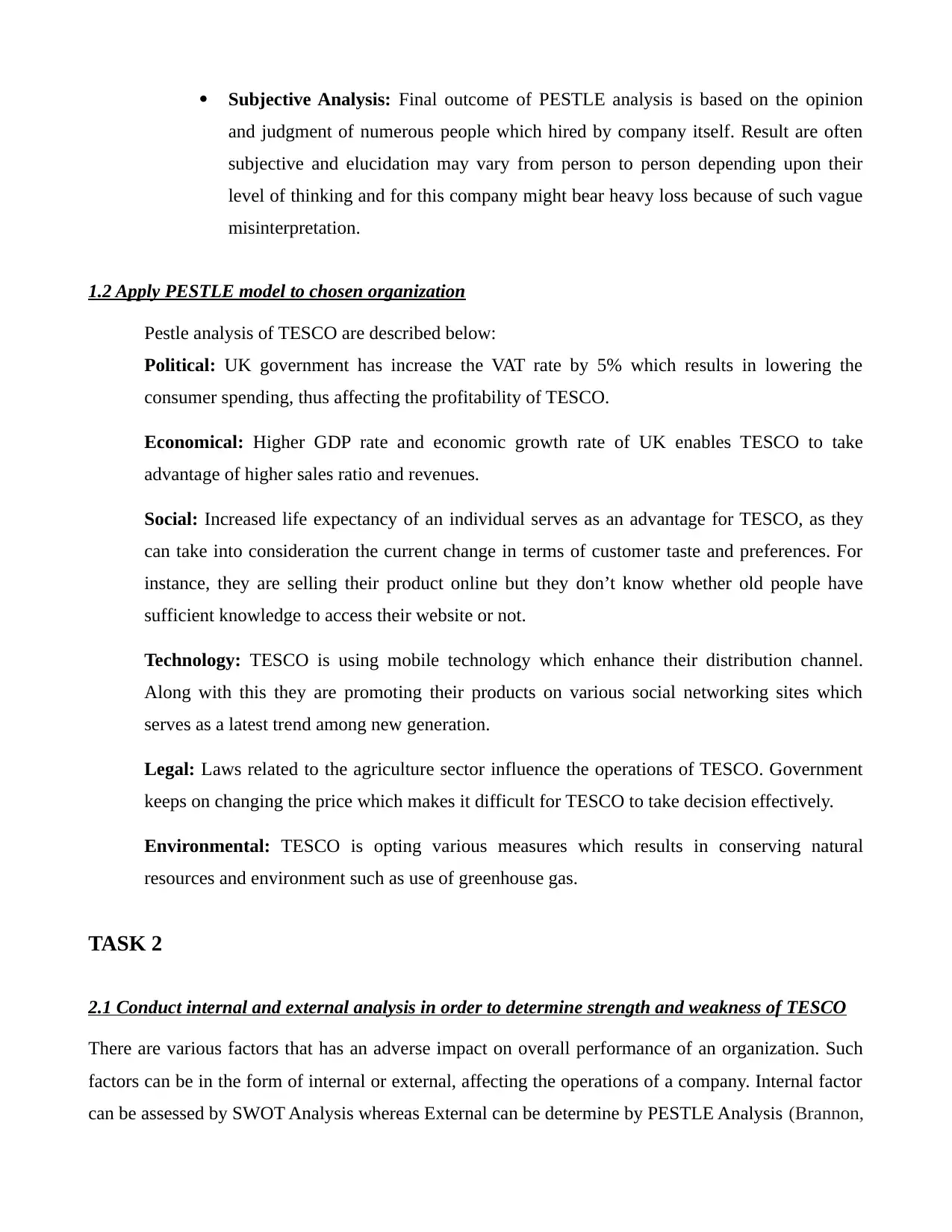
Subjective Analysis: Final outcome of PESTLE analysis is based on the opinion
and judgment of numerous people which hired by company itself. Result are often
subjective and elucidation may vary from person to person depending upon their
level of thinking and for this company might bear heavy loss because of such vague
misinterpretation.
1.2 Apply PESTLE model to chosen organization
Pestle analysis of TESCO are described below:
Political: UK government has increase the VAT rate by 5% which results in lowering the
consumer spending, thus affecting the profitability of TESCO.
Economical: Higher GDP rate and economic growth rate of UK enables TESCO to take
advantage of higher sales ratio and revenues.
Social: Increased life expectancy of an individual serves as an advantage for TESCO, as they
can take into consideration the current change in terms of customer taste and preferences. For
instance, they are selling their product online but they don’t know whether old people have
sufficient knowledge to access their website or not.
Technology: TESCO is using mobile technology which enhance their distribution channel.
Along with this they are promoting their products on various social networking sites which
serves as a latest trend among new generation.
Legal: Laws related to the agriculture sector influence the operations of TESCO. Government
keeps on changing the price which makes it difficult for TESCO to take decision effectively.
Environmental: TESCO is opting various measures which results in conserving natural
resources and environment such as use of greenhouse gas.
TASK 2
2.1 Conduct internal and external analysis in order to determine strength and weakness of TESCO
There are various factors that has an adverse impact on overall performance of an organization. Such
factors can be in the form of internal or external, affecting the operations of a company. Internal factor
can be assessed by SWOT Analysis whereas External can be determine by PESTLE Analysis (Brannon,
and judgment of numerous people which hired by company itself. Result are often
subjective and elucidation may vary from person to person depending upon their
level of thinking and for this company might bear heavy loss because of such vague
misinterpretation.
1.2 Apply PESTLE model to chosen organization
Pestle analysis of TESCO are described below:
Political: UK government has increase the VAT rate by 5% which results in lowering the
consumer spending, thus affecting the profitability of TESCO.
Economical: Higher GDP rate and economic growth rate of UK enables TESCO to take
advantage of higher sales ratio and revenues.
Social: Increased life expectancy of an individual serves as an advantage for TESCO, as they
can take into consideration the current change in terms of customer taste and preferences. For
instance, they are selling their product online but they don’t know whether old people have
sufficient knowledge to access their website or not.
Technology: TESCO is using mobile technology which enhance their distribution channel.
Along with this they are promoting their products on various social networking sites which
serves as a latest trend among new generation.
Legal: Laws related to the agriculture sector influence the operations of TESCO. Government
keeps on changing the price which makes it difficult for TESCO to take decision effectively.
Environmental: TESCO is opting various measures which results in conserving natural
resources and environment such as use of greenhouse gas.
TASK 2
2.1 Conduct internal and external analysis in order to determine strength and weakness of TESCO
There are various factors that has an adverse impact on overall performance of an organization. Such
factors can be in the form of internal or external, affecting the operations of a company. Internal factor
can be assessed by SWOT Analysis whereas External can be determine by PESTLE Analysis (Brannon,
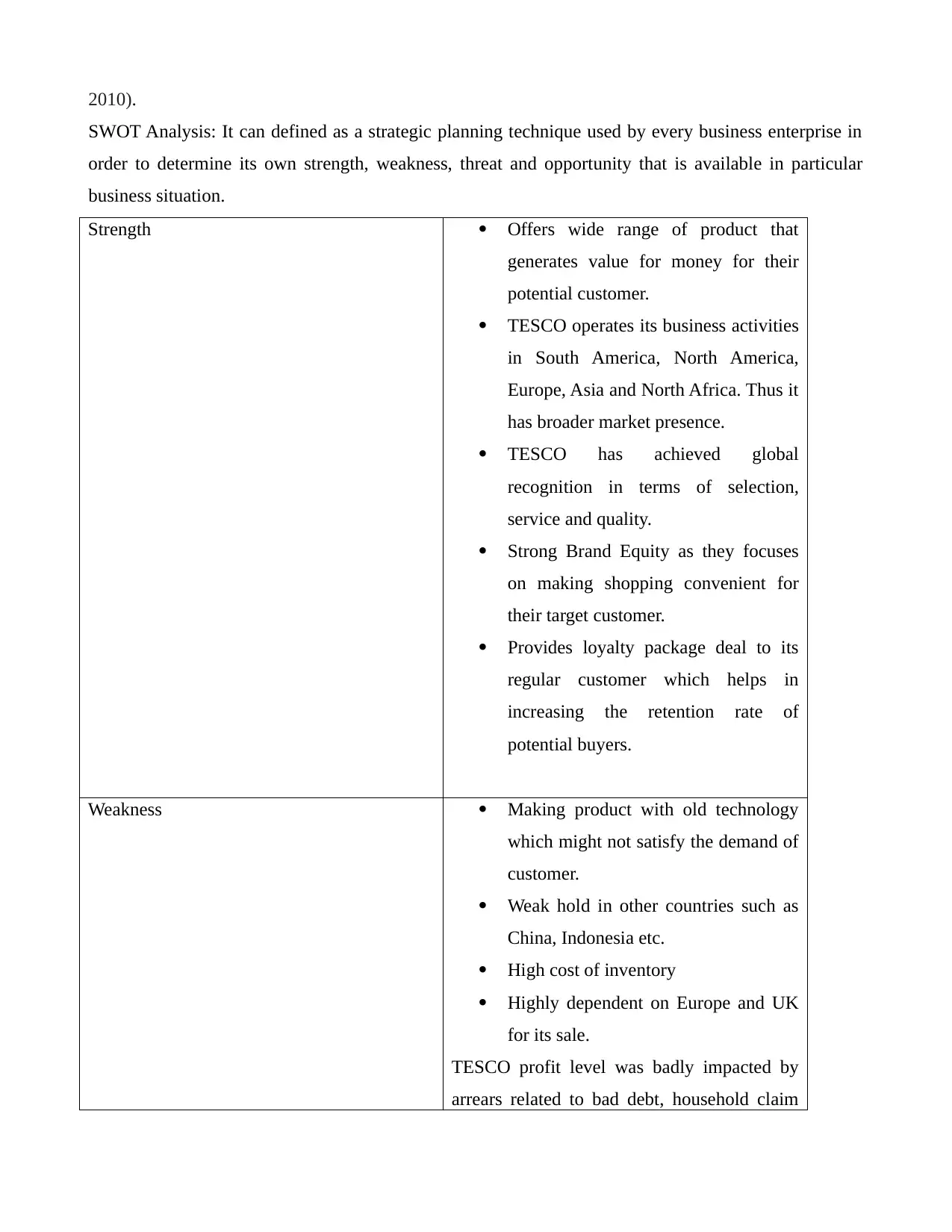
2010).
SWOT Analysis: It can defined as a strategic planning technique used by every business enterprise in
order to determine its own strength, weakness, threat and opportunity that is available in particular
business situation.
Strength Offers wide range of product that
generates value for money for their
potential customer.
TESCO operates its business activities
in South America, North America,
Europe, Asia and North Africa. Thus it
has broader market presence.
TESCO has achieved global
recognition in terms of selection,
service and quality.
Strong Brand Equity as they focuses
on making shopping convenient for
their target customer.
Provides loyalty package deal to its
regular customer which helps in
increasing the retention rate of
potential buyers.
Weakness Making product with old technology
which might not satisfy the demand of
customer.
Weak hold in other countries such as
China, Indonesia etc.
High cost of inventory
Highly dependent on Europe and UK
for its sale.
TESCO profit level was badly impacted by
arrears related to bad debt, household claim
SWOT Analysis: It can defined as a strategic planning technique used by every business enterprise in
order to determine its own strength, weakness, threat and opportunity that is available in particular
business situation.
Strength Offers wide range of product that
generates value for money for their
potential customer.
TESCO operates its business activities
in South America, North America,
Europe, Asia and North Africa. Thus it
has broader market presence.
TESCO has achieved global
recognition in terms of selection,
service and quality.
Strong Brand Equity as they focuses
on making shopping convenient for
their target customer.
Provides loyalty package deal to its
regular customer which helps in
increasing the retention rate of
potential buyers.
Weakness Making product with old technology
which might not satisfy the demand of
customer.
Weak hold in other countries such as
China, Indonesia etc.
High cost of inventory
Highly dependent on Europe and UK
for its sale.
TESCO profit level was badly impacted by
arrears related to bad debt, household claim
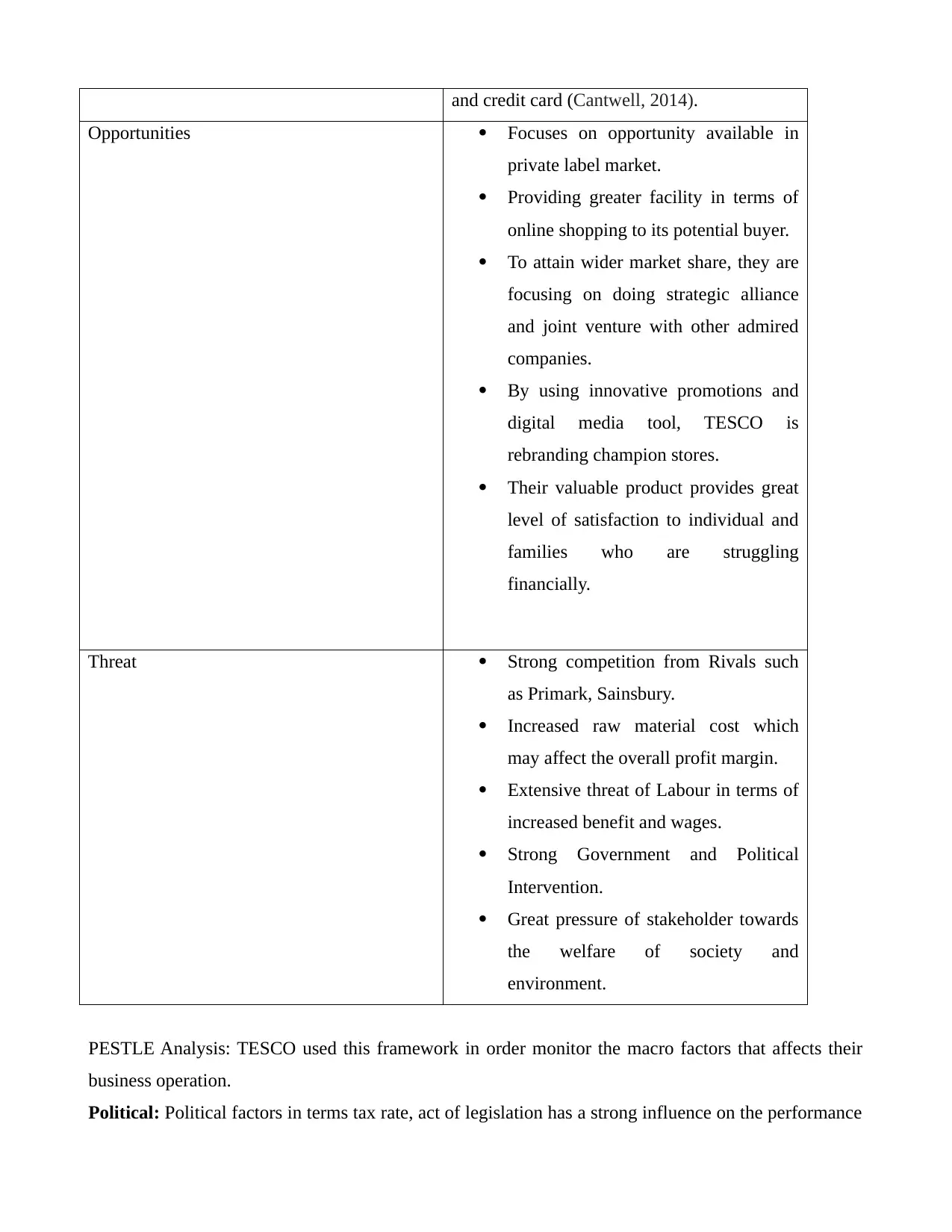
and credit card (Cantwell, 2014).
Opportunities Focuses on opportunity available in
private label market.
Providing greater facility in terms of
online shopping to its potential buyer.
To attain wider market share, they are
focusing on doing strategic alliance
and joint venture with other admired
companies.
By using innovative promotions and
digital media tool, TESCO is
rebranding champion stores.
Their valuable product provides great
level of satisfaction to individual and
families who are struggling
financially.
Threat Strong competition from Rivals such
as Primark, Sainsbury.
Increased raw material cost which
may affect the overall profit margin.
Extensive threat of Labour in terms of
increased benefit and wages.
Strong Government and Political
Intervention.
Great pressure of stakeholder towards
the welfare of society and
environment.
PESTLE Analysis: TESCO used this framework in order monitor the macro factors that affects their
business operation.
Political: Political factors in terms tax rate, act of legislation has a strong influence on the performance
Opportunities Focuses on opportunity available in
private label market.
Providing greater facility in terms of
online shopping to its potential buyer.
To attain wider market share, they are
focusing on doing strategic alliance
and joint venture with other admired
companies.
By using innovative promotions and
digital media tool, TESCO is
rebranding champion stores.
Their valuable product provides great
level of satisfaction to individual and
families who are struggling
financially.
Threat Strong competition from Rivals such
as Primark, Sainsbury.
Increased raw material cost which
may affect the overall profit margin.
Extensive threat of Labour in terms of
increased benefit and wages.
Strong Government and Political
Intervention.
Great pressure of stakeholder towards
the welfare of society and
environment.
PESTLE Analysis: TESCO used this framework in order monitor the macro factors that affects their
business operation.
Political: Political factors in terms tax rate, act of legislation has a strong influence on the performance
Secure Best Marks with AI Grader
Need help grading? Try our AI Grader for instant feedback on your assignments.
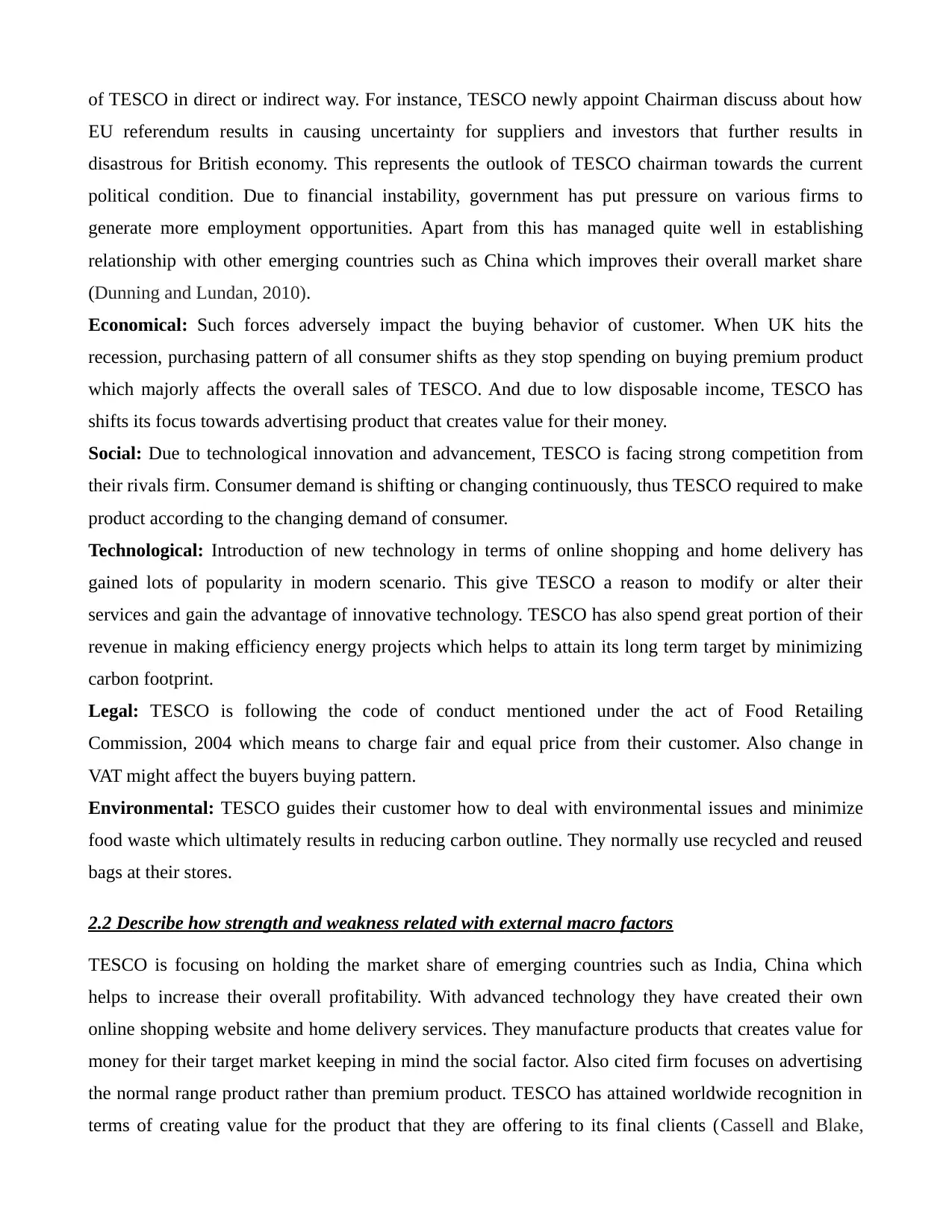
of TESCO in direct or indirect way. For instance, TESCO newly appoint Chairman discuss about how
EU referendum results in causing uncertainty for suppliers and investors that further results in
disastrous for British economy. This represents the outlook of TESCO chairman towards the current
political condition. Due to financial instability, government has put pressure on various firms to
generate more employment opportunities. Apart from this has managed quite well in establishing
relationship with other emerging countries such as China which improves their overall market share
(Dunning and Lundan, 2010).
Economical: Such forces adversely impact the buying behavior of customer. When UK hits the
recession, purchasing pattern of all consumer shifts as they stop spending on buying premium product
which majorly affects the overall sales of TESCO. And due to low disposable income, TESCO has
shifts its focus towards advertising product that creates value for their money.
Social: Due to technological innovation and advancement, TESCO is facing strong competition from
their rivals firm. Consumer demand is shifting or changing continuously, thus TESCO required to make
product according to the changing demand of consumer.
Technological: Introduction of new technology in terms of online shopping and home delivery has
gained lots of popularity in modern scenario. This give TESCO a reason to modify or alter their
services and gain the advantage of innovative technology. TESCO has also spend great portion of their
revenue in making efficiency energy projects which helps to attain its long term target by minimizing
carbon footprint.
Legal: TESCO is following the code of conduct mentioned under the act of Food Retailing
Commission, 2004 which means to charge fair and equal price from their customer. Also change in
VAT might affect the buyers buying pattern.
Environmental: TESCO guides their customer how to deal with environmental issues and minimize
food waste which ultimately results in reducing carbon outline. They normally use recycled and reused
bags at their stores.
2.2 Describe how strength and weakness related with external macro factors
TESCO is focusing on holding the market share of emerging countries such as India, China which
helps to increase their overall profitability. With advanced technology they have created their own
online shopping website and home delivery services. They manufacture products that creates value for
money for their target market keeping in mind the social factor. Also cited firm focuses on advertising
the normal range product rather than premium product. TESCO has attained worldwide recognition in
terms of creating value for the product that they are offering to its final clients (Cassell and Blake,
EU referendum results in causing uncertainty for suppliers and investors that further results in
disastrous for British economy. This represents the outlook of TESCO chairman towards the current
political condition. Due to financial instability, government has put pressure on various firms to
generate more employment opportunities. Apart from this has managed quite well in establishing
relationship with other emerging countries such as China which improves their overall market share
(Dunning and Lundan, 2010).
Economical: Such forces adversely impact the buying behavior of customer. When UK hits the
recession, purchasing pattern of all consumer shifts as they stop spending on buying premium product
which majorly affects the overall sales of TESCO. And due to low disposable income, TESCO has
shifts its focus towards advertising product that creates value for their money.
Social: Due to technological innovation and advancement, TESCO is facing strong competition from
their rivals firm. Consumer demand is shifting or changing continuously, thus TESCO required to make
product according to the changing demand of consumer.
Technological: Introduction of new technology in terms of online shopping and home delivery has
gained lots of popularity in modern scenario. This give TESCO a reason to modify or alter their
services and gain the advantage of innovative technology. TESCO has also spend great portion of their
revenue in making efficiency energy projects which helps to attain its long term target by minimizing
carbon footprint.
Legal: TESCO is following the code of conduct mentioned under the act of Food Retailing
Commission, 2004 which means to charge fair and equal price from their customer. Also change in
VAT might affect the buyers buying pattern.
Environmental: TESCO guides their customer how to deal with environmental issues and minimize
food waste which ultimately results in reducing carbon outline. They normally use recycled and reused
bags at their stores.
2.2 Describe how strength and weakness related with external macro factors
TESCO is focusing on holding the market share of emerging countries such as India, China which
helps to increase their overall profitability. With advanced technology they have created their own
online shopping website and home delivery services. They manufacture products that creates value for
money for their target market keeping in mind the social factor. Also cited firm focuses on advertising
the normal range product rather than premium product. TESCO has attained worldwide recognition in
terms of creating value for the product that they are offering to its final clients (Cassell and Blake,
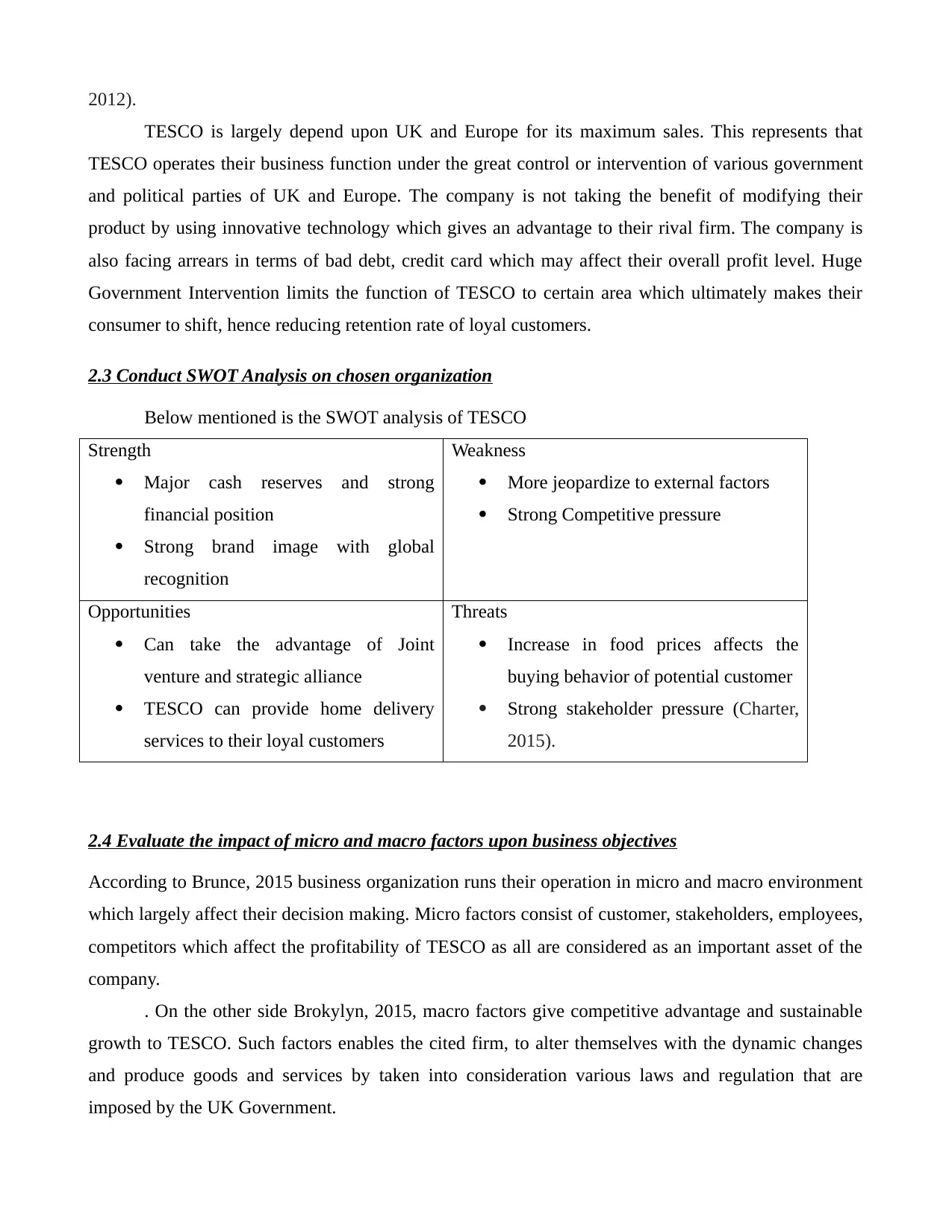
2012).
TESCO is largely depend upon UK and Europe for its maximum sales. This represents that
TESCO operates their business function under the great control or intervention of various government
and political parties of UK and Europe. The company is not taking the benefit of modifying their
product by using innovative technology which gives an advantage to their rival firm. The company is
also facing arrears in terms of bad debt, credit card which may affect their overall profit level. Huge
Government Intervention limits the function of TESCO to certain area which ultimately makes their
consumer to shift, hence reducing retention rate of loyal customers.
2.3 Conduct SWOT Analysis on chosen organization
Below mentioned is the SWOT analysis of TESCO
Strength
Major cash reserves and strong
financial position
Strong brand image with global
recognition
Weakness
More jeopardize to external factors
Strong Competitive pressure
Opportunities
Can take the advantage of Joint
venture and strategic alliance
TESCO can provide home delivery
services to their loyal customers
Threats
Increase in food prices affects the
buying behavior of potential customer
Strong stakeholder pressure (Charter,
2015).
2.4 Evaluate the impact of micro and macro factors upon business objectives
According to Brunce, 2015 business organization runs their operation in micro and macro environment
which largely affect their decision making. Micro factors consist of customer, stakeholders, employees,
competitors which affect the profitability of TESCO as all are considered as an important asset of the
company.
. On the other side Brokylyn, 2015, macro factors give competitive advantage and sustainable
growth to TESCO. Such factors enables the cited firm, to alter themselves with the dynamic changes
and produce goods and services by taken into consideration various laws and regulation that are
imposed by the UK Government.
TESCO is largely depend upon UK and Europe for its maximum sales. This represents that
TESCO operates their business function under the great control or intervention of various government
and political parties of UK and Europe. The company is not taking the benefit of modifying their
product by using innovative technology which gives an advantage to their rival firm. The company is
also facing arrears in terms of bad debt, credit card which may affect their overall profit level. Huge
Government Intervention limits the function of TESCO to certain area which ultimately makes their
consumer to shift, hence reducing retention rate of loyal customers.
2.3 Conduct SWOT Analysis on chosen organization
Below mentioned is the SWOT analysis of TESCO
Strength
Major cash reserves and strong
financial position
Strong brand image with global
recognition
Weakness
More jeopardize to external factors
Strong Competitive pressure
Opportunities
Can take the advantage of Joint
venture and strategic alliance
TESCO can provide home delivery
services to their loyal customers
Threats
Increase in food prices affects the
buying behavior of potential customer
Strong stakeholder pressure (Charter,
2015).
2.4 Evaluate the impact of micro and macro factors upon business objectives
According to Brunce, 2015 business organization runs their operation in micro and macro environment
which largely affect their decision making. Micro factors consist of customer, stakeholders, employees,
competitors which affect the profitability of TESCO as all are considered as an important asset of the
company.
. On the other side Brokylyn, 2015, macro factors give competitive advantage and sustainable
growth to TESCO. Such factors enables the cited firm, to alter themselves with the dynamic changes
and produce goods and services by taken into consideration various laws and regulation that are
imposed by the UK Government.
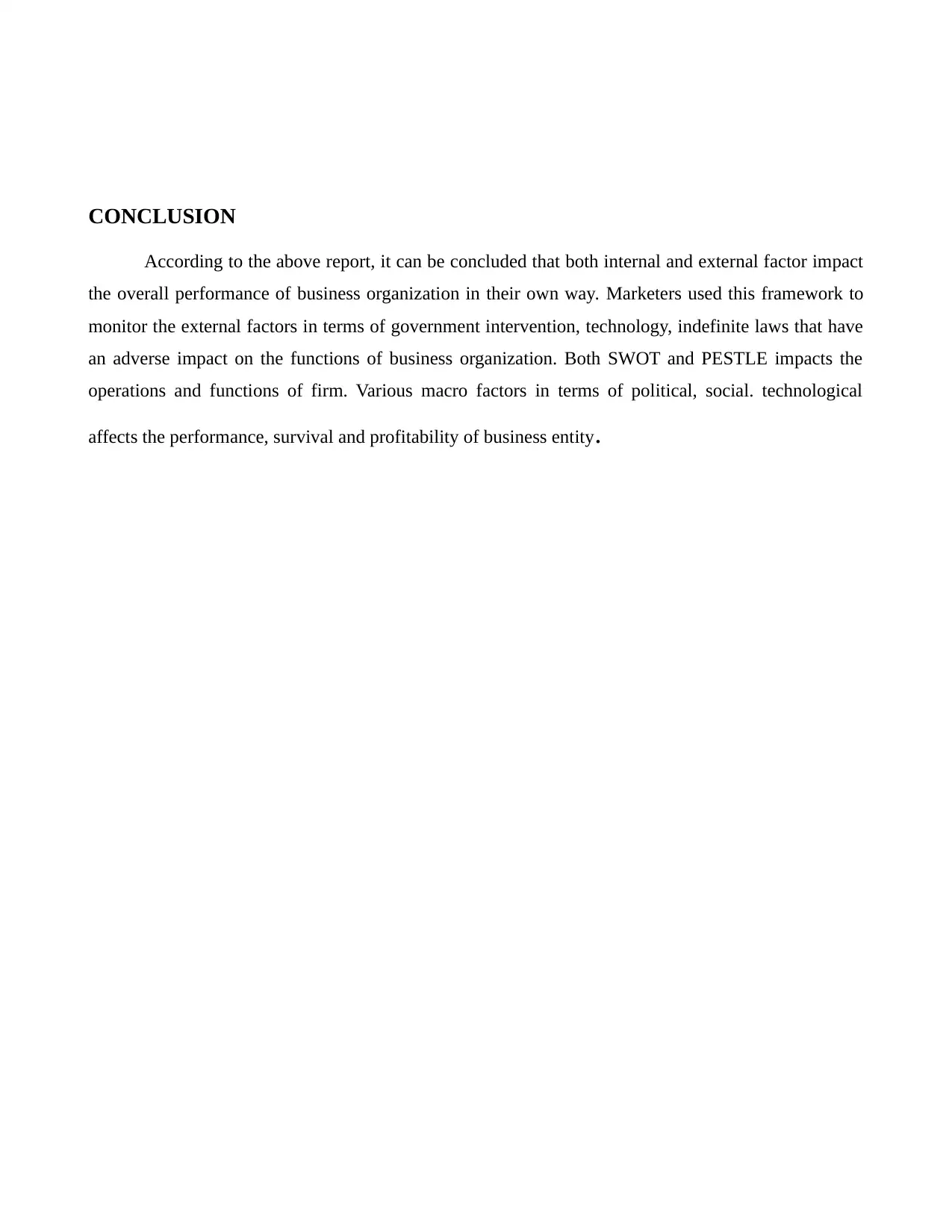
CONCLUSION
According to the above report, it can be concluded that both internal and external factor impact
the overall performance of business organization in their own way. Marketers used this framework to
monitor the external factors in terms of government intervention, technology, indefinite laws that have
an adverse impact on the functions of business organization. Both SWOT and PESTLE impacts the
operations and functions of firm. Various macro factors in terms of political, social. technological
affects the performance, survival and profitability of business entity.
According to the above report, it can be concluded that both internal and external factor impact
the overall performance of business organization in their own way. Marketers used this framework to
monitor the external factors in terms of government intervention, technology, indefinite laws that have
an adverse impact on the functions of business organization. Both SWOT and PESTLE impacts the
operations and functions of firm. Various macro factors in terms of political, social. technological
affects the performance, survival and profitability of business entity.
Paraphrase This Document
Need a fresh take? Get an instant paraphrase of this document with our AI Paraphraser
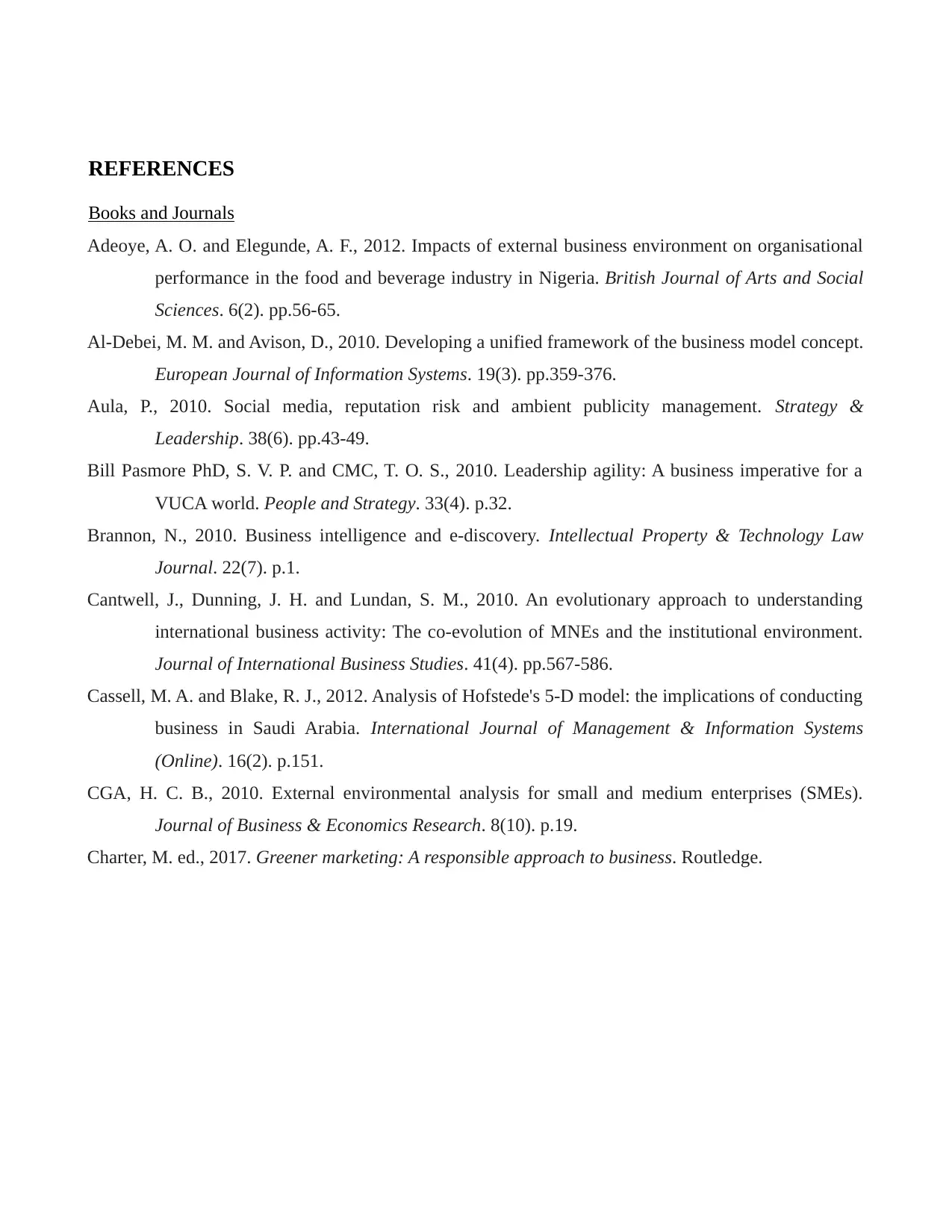
REFERENCES
Books and Journals
Adeoye, A. O. and Elegunde, A. F., 2012. Impacts of external business environment on organisational
performance in the food and beverage industry in Nigeria. British Journal of Arts and Social
Sciences. 6(2). pp.56-65.
Al-Debei, M. M. and Avison, D., 2010. Developing a unified framework of the business model concept.
European Journal of Information Systems. 19(3). pp.359-376.
Aula, P., 2010. Social media, reputation risk and ambient publicity management. Strategy &
Leadership. 38(6). pp.43-49.
Bill Pasmore PhD, S. V. P. and CMC, T. O. S., 2010. Leadership agility: A business imperative for a
VUCA world. People and Strategy. 33(4). p.32.
Brannon, N., 2010. Business intelligence and e-discovery. Intellectual Property & Technology Law
Journal. 22(7). p.1.
Cantwell, J., Dunning, J. H. and Lundan, S. M., 2010. An evolutionary approach to understanding
international business activity: The co-evolution of MNEs and the institutional environment.
Journal of International Business Studies. 41(4). pp.567-586.
Cassell, M. A. and Blake, R. J., 2012. Analysis of Hofstede's 5-D model: the implications of conducting
business in Saudi Arabia. International Journal of Management & Information Systems
(Online). 16(2). p.151.
CGA, H. C. B., 2010. External environmental analysis for small and medium enterprises (SMEs).
Journal of Business & Economics Research. 8(10). p.19.
Charter, M. ed., 2017. Greener marketing: A responsible approach to business. Routledge.
Books and Journals
Adeoye, A. O. and Elegunde, A. F., 2012. Impacts of external business environment on organisational
performance in the food and beverage industry in Nigeria. British Journal of Arts and Social
Sciences. 6(2). pp.56-65.
Al-Debei, M. M. and Avison, D., 2010. Developing a unified framework of the business model concept.
European Journal of Information Systems. 19(3). pp.359-376.
Aula, P., 2010. Social media, reputation risk and ambient publicity management. Strategy &
Leadership. 38(6). pp.43-49.
Bill Pasmore PhD, S. V. P. and CMC, T. O. S., 2010. Leadership agility: A business imperative for a
VUCA world. People and Strategy. 33(4). p.32.
Brannon, N., 2010. Business intelligence and e-discovery. Intellectual Property & Technology Law
Journal. 22(7). p.1.
Cantwell, J., Dunning, J. H. and Lundan, S. M., 2010. An evolutionary approach to understanding
international business activity: The co-evolution of MNEs and the institutional environment.
Journal of International Business Studies. 41(4). pp.567-586.
Cassell, M. A. and Blake, R. J., 2012. Analysis of Hofstede's 5-D model: the implications of conducting
business in Saudi Arabia. International Journal of Management & Information Systems
(Online). 16(2). p.151.
CGA, H. C. B., 2010. External environmental analysis for small and medium enterprises (SMEs).
Journal of Business & Economics Research. 8(10). p.19.
Charter, M. ed., 2017. Greener marketing: A responsible approach to business. Routledge.
1 out of 20
Related Documents
Your All-in-One AI-Powered Toolkit for Academic Success.
+13062052269
info@desklib.com
Available 24*7 on WhatsApp / Email
![[object Object]](/_next/static/media/star-bottom.7253800d.svg)
Unlock your academic potential
© 2024 | Zucol Services PVT LTD | All rights reserved.





